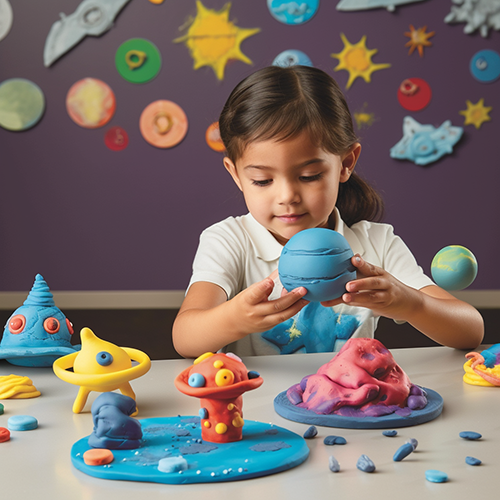Superscript
Small World Play
As A STEAM Activity

STEAM is integrated into small world play by using creative imaginative play scenes to teach science, technology, engineering, art, and math concepts. Children can design and build miniature worlds and use them to explore problem-solving, creativity, and the impact of their actions, which are vital skills for learning.
Small world play supports art skills by fostering fine motor development and creativity. As children manipulate small objects, they build dexterity and hand-eye coordination, which are crucial for tasks like drawing and writing. Additionally, small world play encourages imaginative and creative thinking, as children develop stories, plan scenarios, and design their own miniature worlds using a variety of open-ended materials.
You can watch this video to learn how to create a miniature world using watercolors:
Art skill development through small world play
Fine motor skills: Manipulating small figures, vehicles, and props in a small world play setting helps children develop dexterity, grip strength, and hand-eye coordination. These are essential for later art activities like holding a crayon or paintbrush.
Creativity and imagination: Small world play is a direct pathway to creative expression. Children use open-ended materials to invent their own narratives and build miniature worlds, allowing them to explore ideas and express themselves in a hands-on way.
Problem-solving: Children can use their creativity to solve problems within their miniature world. For example, they might need to figure out how to get a character across a "river" or build a shelter for an animal, which engages their cognitive skills in a way that is transferable to art projects.
Sensory exploration: The use of diverse materials, such as sand, water, playdough, and natural treasures, provides a multi-sensory experience that can be a valuable part of the creative process.
Pre-literacy and narrative: By acting out stories and creating their own narratives, children are developing foundational storytelling skills that are directly linked to how they might later approach artistic tasks like creating a picture book or a comic strip.
This video demonstrates how to play the board game Small World, which can be used as an example of STEAM in action:
Watch It Played-YouTube • Aug 13, 2019
Integrating STEAM into small world play
Science: Children can explore themes like dinosaurs, the ocean, or the weather by using small world setups that reflect these environments, as shown in this Twinkl article and this Teach Early Years article. They can also add sensory materials like water, sand, or rocks to create realistic, immersive experiences.
Technology: Children can use simple tools like magnifying glasses or even tablets to learn about technology in a hands-on way.
Engineering: Children can use their creativity to build structures, bridges, or other objects within their small world, using materials like blocks, sticks, and even natural materials.
Art: Children can use their small world to create stories and characters. They can paint backdrops or create props for their scenes.
Math: Children can learn about counting, sorting, and simple math concepts by using small world play setups that involve counting small objects or sorting them by color or size.
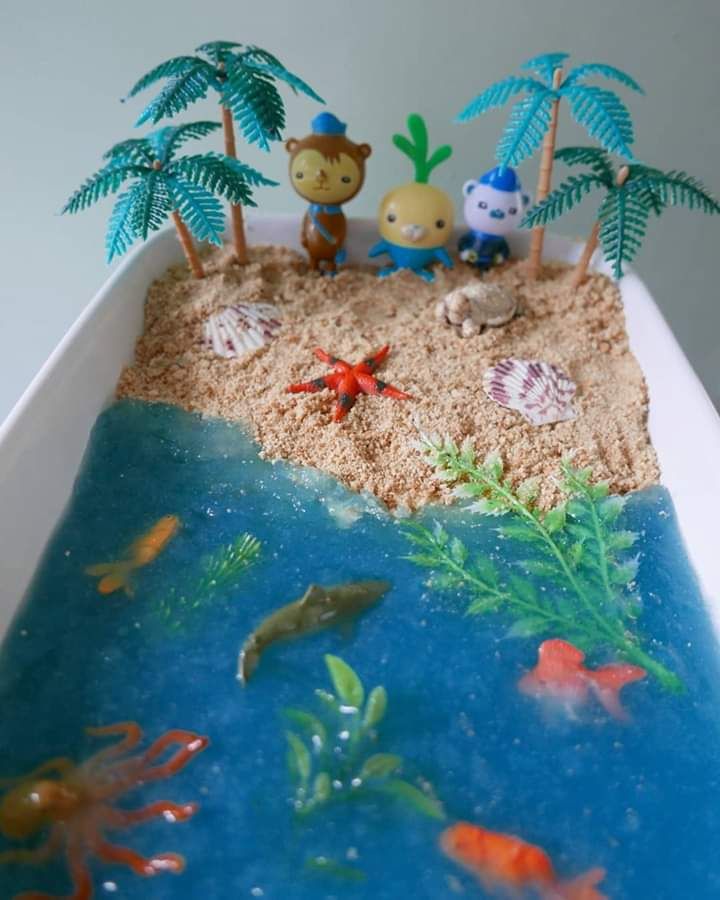
Why small world play is important
Problem-solving: Small world play encourages children to find solutions to problems they encounter within their play scenarios, which helps them to develop their problem-solving abilities.
Creativity: By creating their own worlds and characters, children can unleash their creativity and imagination.
Social skills: Small world play allows children to interact with each other and to work together to achieve a common goal.
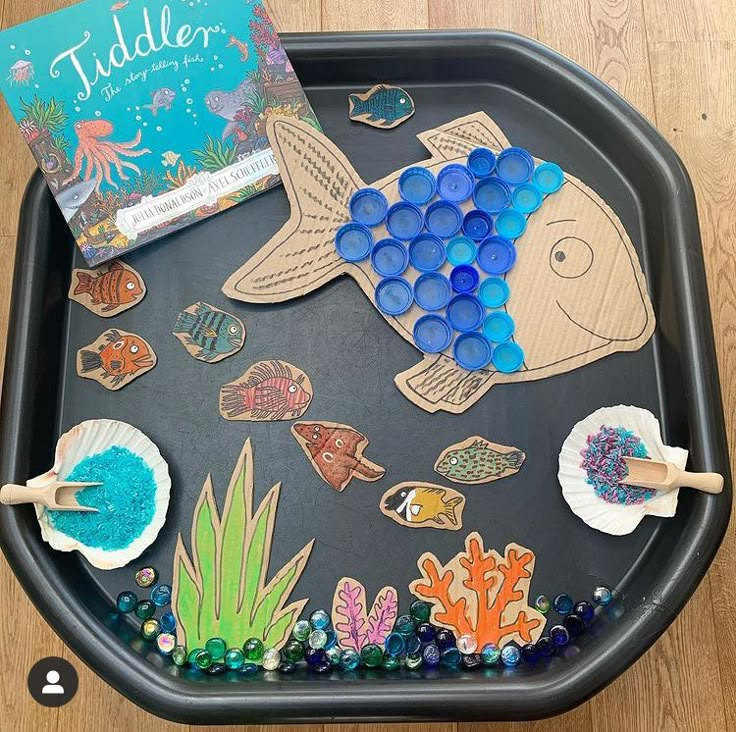
The art skills needed for small world play include developing and applying art fundamentals like color, line, shape, and texture, and using materials for sculpture, drawing, and construction. Key skills involve imagination for creating themes and narratives, fine motor skills for manipulation and construction, and the ability to represent concepts using different mediums like clay, drawing tools, or found objects.
Art fundamentals
Color: Using different colored materials, like silk, fabric, or paint, to suggest different environments such as green for grass or blue for water.
Line and shape: Drawing lines for roads on a cardboard box, or shaping objects from clay to create a castle or trees.
Form: Creating three-dimensional objects, such as small houses from clay, or building structures with blocks.
Texture: Incorporating various textures through materials like kinetic sand, pebbles, or fabric to make the small world more realistic and tactile.
Skills for creation and representation
Sculpting: Using materials like clay to create figures, mushrooms, houses, or other custom elements for the world.
Drawing and writing: Using pens, crayons, or markers to draw backdrops, roads, and labels on cardboard or other surfaces.
Construction: Building with blocks, recycled boxes, or other construction materials to form landscapes and structures.
Collection and adaptation: Using and repurposing everyday items like twigs, acorns, or even cafeteria sporks as creative building materials to represent different parts of the world.
Process and imagination
Imaginative planning: Before creating, consider the theme (jungle, desert, city), inhabitants, and what the environment needs.
Problem-solving: Figuring out how to create a specific element, like making a pointy tree from a coil of clay, shows problem-solving skills. Make sure you have the appropriate food, shelter and water in the environment for the animals.
Narrative building: Integrating toys like animals or cars into the scene to create a story, like a turtle driving a car on a path of rocks.
Self-expression: Enjoying the process of making and sharing the creation, which is a form of self-expression and creativity.
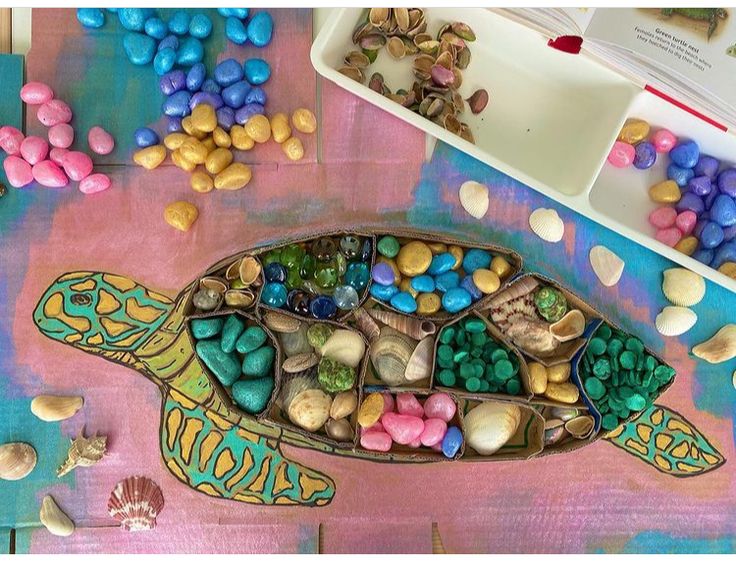
Combine science and art for children by creating projects that are both hands-on and educational, such as using capillary action for salt painting, exploring centrifugal force with spin art, or building and decorating models like a solar system or animal habitat. Other options include making art with natural materials, experimenting with light and shadows, or building and decorating functional items like a bug viewer.
This video demonstrates how to create salt painting, a fun project that combines art and science:
Sensory and process art
Salt painting: Draw with glue on paper, sprinkle salt over the glue, and then drop watercolors onto the salt to watch the colors spread.
Spin art: Attach paper to a spinning object (like a salad spinner or bicycle wheel) and add paint to create swirling patterns from centrifugal force.
Ice painting: Freeze water with food coloring in ice cube trays. Use the colored ice cubes to paint on paper, observing how the ice melts and colors bleed.
Painting with balls: Roll marbles or balls dipped in paint across a piece of paper to see how they move and create patterns.
Science-based art projects
Building models: Create and decorate models like a solar system in a jar or a worm tower to learn about space or biology.
Circuitry art: Use LED lights to create artwork that explores concepts like open and closed circuits.
Natural art: Go on a sensory nature walk and then create art using collected natural materials like pressed flowers.
Water striders: Design and build a "water strider" bug that can stand on water to learn about surface tension and buoyancy.
You can watch this video to learn how to create magnetic process art, which combines art and science concepts:
Zippi Kids Corner-YouTube • Sep 5, 2021
Illustrating scientific concepts
Color theory: Use art supplies to experiment with color mixing and the scientific principles behind how colors are created.
States of matter: Paint with ice to explore the science of melting and states of matter.
Capillary action: Use salt painting to demonstrate how liquids move through small spaces.
Making art to illustrate science: Draw pictures, build dioramas, or create mobiles to explain concepts like the life cycle of a monarch butterfly or different elements.
Small World Play Tips -
Let’s create an engaging small world setup!
Small world play is always lots of fun!
Let’s create an engaging small world play setup!
Creating a little small world to play with is so much fun! This was a lion small world played with by my 4 year old. She enjoyed creating stories about her lions as she acted them out.
Here’s how this small world was created:
The Small World Invitation to Play …
This beautiful small world play started with a few items placed on a table. I intentionally didn't set it up as a small world this time, rather left the items for my daughter to explore how she wished.
For this invitation to play I used:
A tub of animal figurines
A tub of lucite cubes
A selection of wooden tree pieces - mini logs and rounds
Grimms rainbow
*Important: Please note small parts as shown here are for children ages 3+.
Small world invitation to play
Small world play tips for home
Here’s a few small world play tips that work for us …
Let your child choose what animal or other figurines they would like to play with.
Setting the materials out like this allowed my daughter to choose which animals she wanted to play with and how she wanted to play.
She tried to find animals that had enough figurines to represent our family. She tried the giraffes first, but only counted 4. After trying to count out a few different animals with no luck she asked for my help. The lions had the perfect amount and she even added in another family member too!
Play allows children to explore things that are important to them in their world.
Let your child explore how they wish
An invitation to play doesn’t need to always be set up as a complete small world.
Try putting out a selection of items that could be used to create a small world. We used wooden pieces, Grimms pastel rainbow and natural semi circles and lucite cubes.
Let your child decide how they would like to create their world or build it with them.
Sometimes I will set things up for them, but I have found they always enjoy creating their own worlds. We do a mix of both!
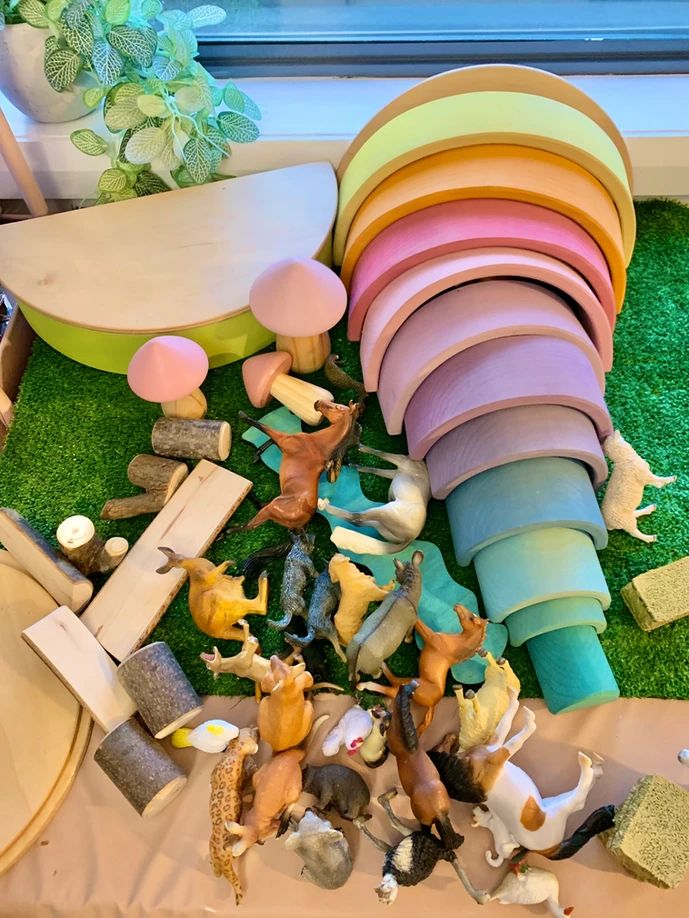
Small world play with open ended materials
Show how open-ended toys can be played with …
Sometimes it can be a good idea to show how open ended toys, such as the rainbows can be used. This allows children to try out new ideas and feel inspired in their play in the future when they play with the same toys.
Showing the possibilities of open ended toys can be very helpful to begin with and is a great way to support your child’s play.
I showed Miss 4 how the rainbow can make a cave. She really liked this as a home for her lions. We grabbed the Grimms natural semi circles and made a stack too. Now she knows how to do this she will be able to create them herself as she plays.
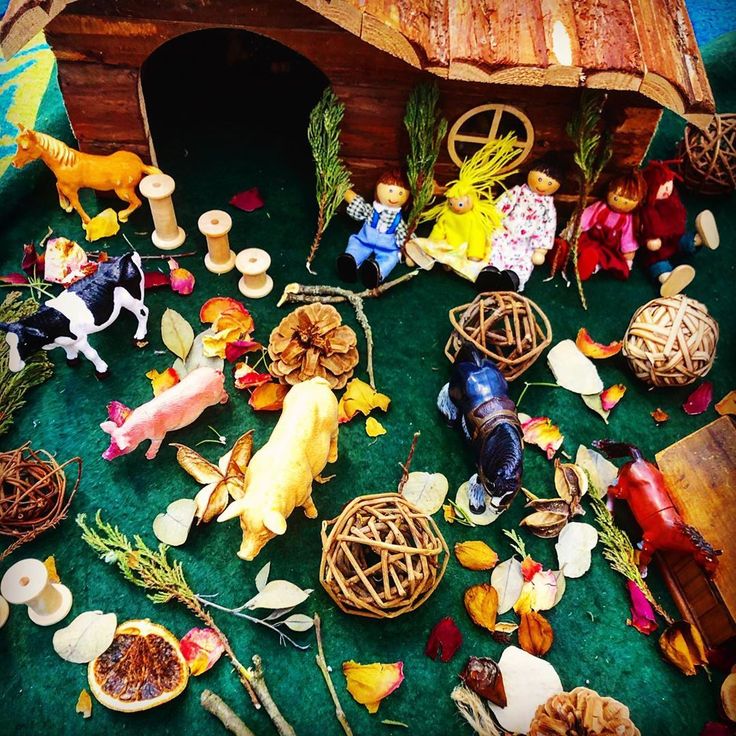
Small world play is great for developing imagination
Leave the materials out to explore
Offering children the opportunity to explore materials again on a different occasion can be a wonderful way to see their play develop and change over time.
We have had the same materials out for over a week now and they have been used for a farm animal small world too.
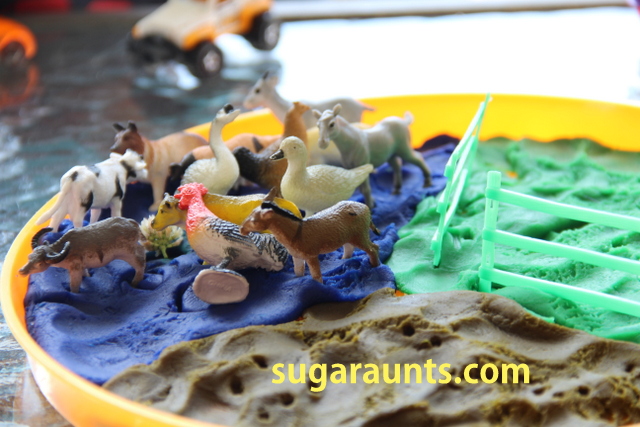
Farm small world play
Small world play is lots of fun , with so many possibilities for play and learning too!
I hope you found an idea or two today to try or maybe something that you’re already doing.
You may also enjoy:
HOW TO MAKE THE MOST USE OUT OF TOYS
Montessori-inspired hands-on activities with vehicles. How to make the most out of the toys
Montessori-inspired & hands-on activities with Lego Duplo. How to make the most out of toys
Science and Art Videos for Kids | STEAM Education & Science ...
YouTube · Kylee Makes It - Art Videos for Kids
YouTube · TheDadLab
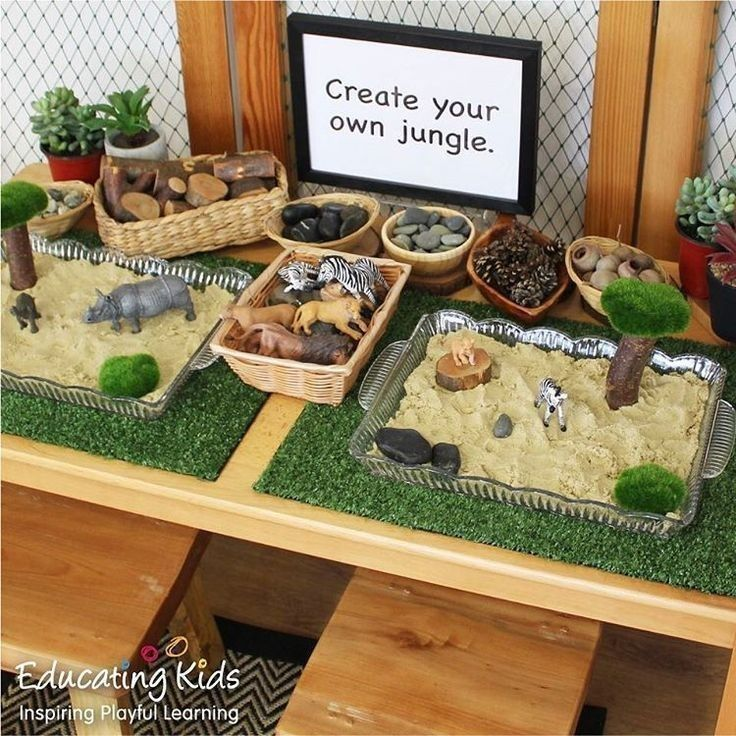
Exploring Creativity:
“Small world play is acting out scenarios (scenes from real life, stories and/or imagination) in a miniature play scene, created with small figures and objects. Anything from your own home or garden will do, there is no limitation to your creativity which is why it’s a truly inexhaustible subject!” (Little Worlds Big Adventures)
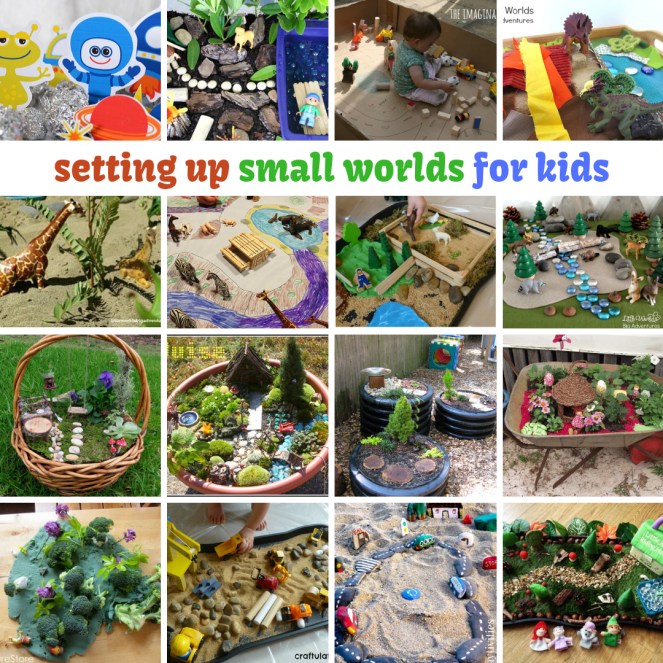
There are many ways that small world play can benefit children:
sensory – they can investigate and explore different materials and textures, and it can be calming and comforting for children who are feeling anxious or upset
imaginary play – they can take on different roles and work through difficult feelings in a safe environment
literacy – they can tell and/or retell stories, and expand their vocabulary and understanding of concepts (next to, on top of, behind, in front of, under, over)
numeracy – they can count, sort and classify different objects
creativity – they can express their own unique creativity by deciding on the kind of small world they want to create and the elements they want to include
social skills – they can develop these skills through playing with others, negotiating, taking turns, and cooperating in their play
fine motor skills and hand/eye coordination – they can develop these skills through manipulating small objects
concentration/focus and independence in play – they can get totally engrossed in their small worlds and the stories they tell about them
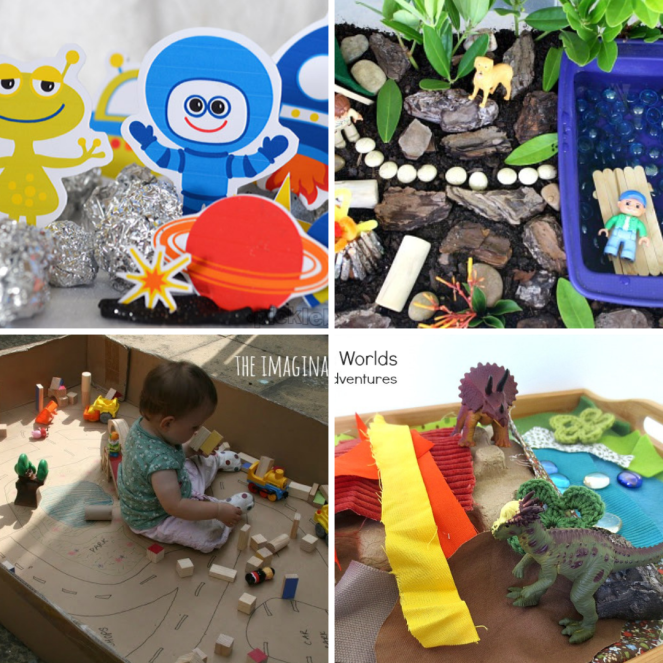
Sources: Picklebums, The imagination tree, Fantastic fun and learning, Little worlds big adventures
Here are just some examples of themes you can use for your child’s small worlds:
book/story based – other people’s stories or their own (real or made up)
gardens – bugs, dinosaurs, fairies
habitats – beach/ocean, desert/safari, forest/jungle, snow/ice, woodland
settings – aquarium, camping, construction/transport, farm, space, zoo
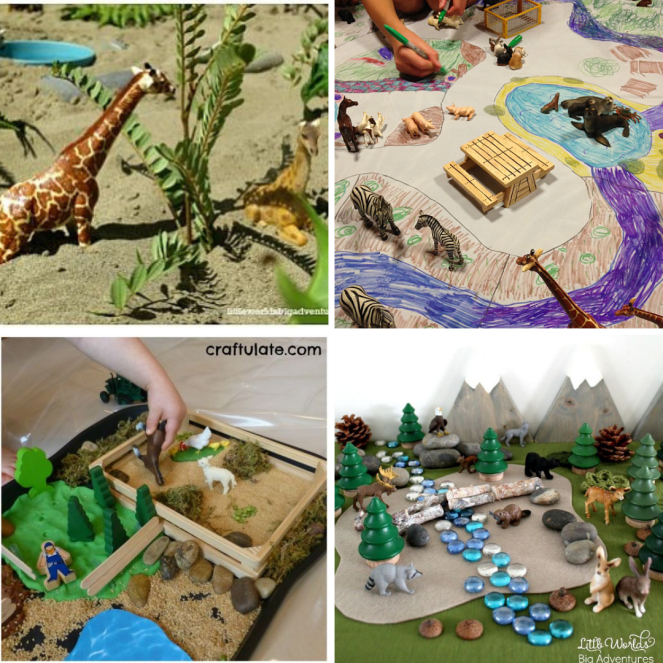
Sources: Little worlds big adventures, Craftulate, You clever monkey
Here are some ideas for your kids to use as a base for their small worlds to keep all the elements contained in a small space:
baskets
cardboard/wooden boxes
felt/fabric play mats/blankets
sandpits
suitcases
tables
trays
tyres/wheelbarrows
wooden crates
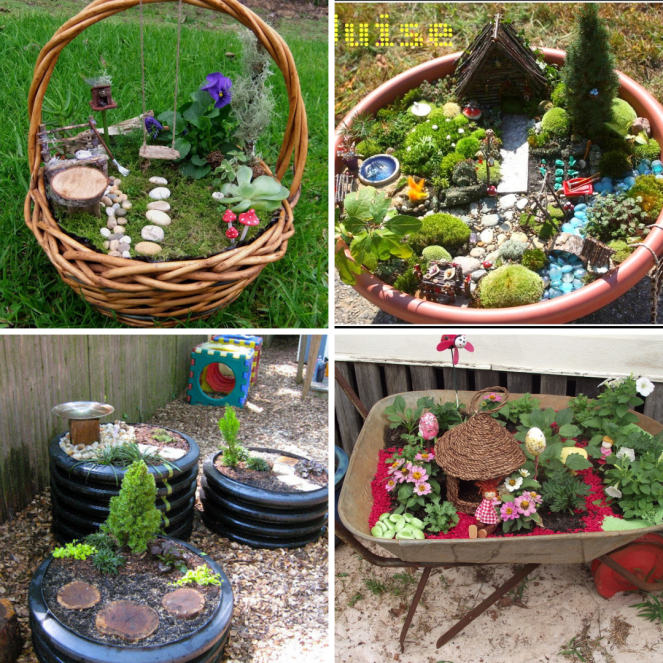
Sources: This, that and everything in between, Let the children play, The empowered educator online, Juise
Here are some ideas for materials that your kids can use to put their small worlds together:
sand/dirt/mud/gravel/pebbles/stones
water/ice
flowers/herbs/moss/grass/leaves/succulents/other small plants
bark/twigs/sticks/driftwood/wood rounds
pine cones/gum nuts/acorns/straw/shells
rice/pasta/dried beans/popping corn/dry cereal
play dough/sand dough/cloud dough/salt dough
wooden beads/buttons/clothes pegs/popsticks/spools
glass gems
pipe cleaners/popsticks
twine/raffia
felt/fabric shapes/scraps. ribbons/ric rac
recycled materials (paper/cardboard/containers)
miniature wooden people/animals/trees/logs
small toys (cars/trains/wooden blocks/figurines)
tape
paint/crayons/markers
** For younger kids, keep it simple and safe by not including items that might be a choking hazard
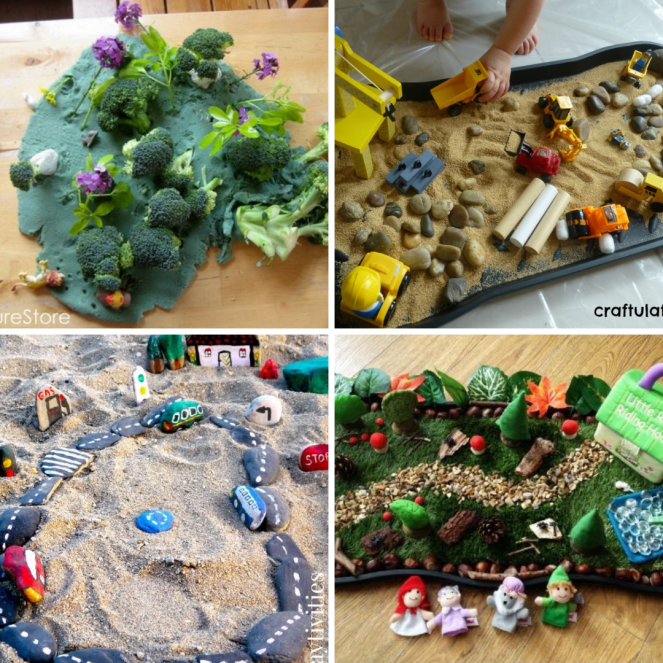
Sources: NurtureStore, Playtivities, Craftulate, Learning and exploring through play
Encouraging Art STEM Activities for Kids
This article was written by and sponsored by the
I’m a Chef Too Staff
Table of Contents
Introduction
The "A" in STEAM: Why Art Matters So Much
Art STEM Activities Through the Lens of Science
Art STEM Activities Through the Lens of Technology & Engineering
Art STEM Activities Through the Lens of Math
I'm the Chef Too!: Where Culinary Arts Meet STEM & Fun
Beyond the Kitchen: Everyday Art STEM Activities at Home
Tips for Parents & Educators: Fostering a STEAM Mindset
Choosing the Right Art STEM Activities for Your Child
Conclusion
FAQ: Your Questions About Art STEM Activities Answered
Have you ever watched a child completely absorbed in an activity, their eyes wide with wonder, their hands busy, and their mind buzzing with questions? Perhaps they’re molding playdough into fantastical creatures, mixing paint colors to create a sunset, or meticulously stacking blocks to build a towering fort. These moments, often dismissed as simple play, are actually powerful learning experiences. They're where art meets science, technology, engineering, and math – the core of what we call STEAM education. And at I'm the Chef Too!, we believe the kitchen is one of the most exciting places for these connections to happen!
We've all seen the growing emphasis on STEM – Science, Technology, Engineering, and Mathematics – in education. But increasingly, the importance of the "A" for Arts is being recognized, transforming STEM into STEAM. Why? Because integrating art into these subjects doesn't just make learning more fun; it makes it more holistic, more engaging, and more deeply impactful. Art isn't just about painting or drawing; it’s about creative thinking, problem-solving, innovation, and expression. When we combine the logical, analytical thinking of STEM with the imaginative, flexible approach of the arts, we unlock a richer learning experience for children, fostering a well-rounded mind and a lifelong love for discovery.
In this comprehensive guide, we'll dive deep into the world of art STEM activities. We'll explore why blending these disciplines is so beneficial, how you can easily incorporate them into your child's everyday life (especially in the kitchen!), and how our unique approach at I'm the Chef Too! makes learning a delicious adventure. Get ready to discover how to spark curiosity, build confidence, and create unforgettable family memories through the magic of STEAM.
Introduction
Imagine a rainy afternoon, and your child is feeling restless. Instead of reaching for a screen, what if you could offer an activity that not only captivates their attention but also secretly teaches them about chemical reactions, engineering principles, or mathematical concepts, all while they're creating something beautiful and delicious? This is the power of art STEM activities, and it's at the heart of our mission at I'm the Chef Too!. We believe that blending food, STEM, and the arts into one-of-a-kind "edutainment" experiences is the most effective way to spark curiosity and creativity in children.
Too often, we tend to separate subjects into neat, isolated boxes: science class, art class, math class. But in the real world, innovation rarely happens in a vacuum. Artists use geometry, engineers design with aesthetics in mind, and scientists interpret data through visual representations. By weaving art into STEM, we reflect this interconnectedness, teaching children that creativity and critical thinking are not separate skills but rather two sides of the same coin, essential for tackling complex challenges and expressing new ideas.
The purpose of this post is to guide parents and educators through the exciting landscape of art STEM activities, highlighting the immense benefits of this integrated approach. We'll explore various ways to bring these concepts to life, emphasizing hands-on engagement and the joyful process of discovery. You'll learn how simple household items, especially kitchen ingredients, can become powerful tools for learning, and how our expertly designed kits at I'm the Chef Too! provide convenient, pre-packaged adventures that make this blend of learning accessible and exciting for every family.
Our main message is clear: fostering creativity alongside analytical skills prepares children not just for academic success, but for a future where adaptability, innovation, and imaginative problem-solving are paramount.
The "A" in STEAM:
Why Art Matters So Muc h
The addition of "Art" to STEM to create STEAM isn't just a clever acronym; it represents a fundamental shift in how we approach education. Art isn't merely about self-expression or aesthetic appreciation; it's a powerful tool for learning that enhances every other discipline. When children engage in art STEM activities, they activate different parts of their brain simultaneously, leading to richer neural connections and a more profound understanding of concepts.
Here’s why integrating art is so vital for your child’s development:
Holistic Brain Development: Art activities engage the "right brain" – the center of creativity, intuition, and emotional processing – while STEM activities typically lean on the "left brain" for logic, analysis, and sequencing. Combining them ensures both hemispheres are actively working together. This "whole-brain" approach helps children develop comprehensive problem-solving strategies, allowing them to approach challenges from multiple perspectives.
Enhanced Creativity and Innovation: Art encourages divergent thinking – the ability to come up with many different solutions to a problem. In a world that demands constant innovation, this skill is invaluable. When children are encouraged to think artistically about a scientific problem, they're more likely to discover novel approaches and solutions. For example, designing a stable edible structure (engineering) involves artistic considerations of balance and form.
Improved Problem-Solving and Persistence: Art often involves trial and error, much like scientific experimentation or engineering design. A painting might not turn out as expected, or a sculpture might collapse. These "failures" become opportunities to learn, adapt, and try again. This process builds resilience and persistence, teaching children that challenges are part of the creative journey. Engaging in art STEM activities encourages children to think about their choices, weigh potential risks, and persist in finding creative solutions.
Boosted Fine Motor Skills and Hand-Eye Coordination: Many art activities, from painting and drawing to cutting and molding, require precise movements and coordination. These skills are crucial for everything from writing and dressing themselves to using tools and conducting experiments later in life. In the kitchen, tasks like stirring, pouring, measuring, and decorating are fantastic for developing these essential motor skills.
Stronger Communication and Expression: Art provides a non-verbal outlet for children to express ideas, emotions, and understanding. How would a child visually represent the water cycle? Can they draw the steps of a chemical reaction? This visual communication complements verbal and written forms, making learning more accessible and allowing children to share their knowledge in diverse ways.
Increased Engagement and Motivation: For many children, the hands-on, creative nature of art makes learning more appealing and less intimidating. When learning feels like play, children are more motivated to participate, explore, and retain information. This is a core principle at I'm the Chef Too!: making education so engaging that children don't even realize they're learning. Our unique "edutainment" experiences are designed to be screen-free educational alternatives that captivate young minds.
Social Awareness, Flexibility, and Collaboration: Many art STEM projects are ideal for collaborative work, whether it’s a family working together on a baking project or a group of children designing a miniature city. This fosters teamwork, teaches negotiation, and encourages children to respect different ideas and approaches.
By intentionally integrating the arts into science, technology, engineering, and mathematics, we don't just teach discrete subjects; we cultivate curious, creative, and capable individuals ready to navigate a complex world with ingenuity and confidence. This holistic approach is why we're so passionate about what we do, and why we encourage you to join us in exploring the wonderful world of art STEM activities.
Art STEM Activities Through the Lens of Science
Science is all about observation, experimentation, and understanding the world around us. When we combine it with art, we create truly memorable experiences where children can visualize abstract concepts, witness reactions firsthand, and express their scientific understanding creatively. The kitchen is a natural laboratory for this!
Chemistry in the Kitchen:
Edible Reactions and More
Chemistry is the study of matter and how it changes, and your kitchen is packed with chemical reactions waiting to be explored.
Fizzy Fun with Acids and Bases: Ever made baking soda volcanoes? It’s a classic for a reason! Mixing baking soda (a base) with vinegar (an acid) creates carbon dioxide gas, leading to an exciting eruption. You can make this artistic by adding food coloring to your "lava" and shaping your volcano with dough or clay. These Erupting Volcano Cakes kit brings this concept to life in a delicious way, letting kids witness a chemical reaction that makes cakes bubble over with deliciousness, all while decorating a scientific masterpiece!
Color Mixing and Chromatography: Food coloring is a fantastic art and chemistry tool. Mix primary colors to create secondary and tertiary hues, exploring the science of light and pigments. For a more advanced activity, try marker chromatography. Place a dot of washable marker on a coffee filter or paper towel, then dip the edge in water. As the water absorbs, it separates the different colored pigments that make up the marker ink, creating beautiful, abstract art while teaching about solubility and mixtures. You can even use different food colorings on paper towels for edible chromatography art.
Dissolving and Solutions: Observe what happens when sugar dissolves in water, or how oil and water don't mix. These simple observations teach about solubility and density. Kids can create "density towers" with different colored liquids (like oil, water with food coloring, syrup) to see how liquids layer based on their density, creating a visual spectrum.
States of Matter (Melting and Freezing): Baking and cooking offer constant lessons on states of matter. Melting chocolate, freezing ice cream, or watching dough rise (yeast fermentation!) are all chemical and physical changes. Creating edible sculptures that melt (like ice cream art) or harden (like chocolate molds) combines art with the science of temperature and phase changes.
Biology in Bloom:
From Seed to Snack
Biology is the study of life, and it's everywhere, even in our food!
Edible Plant Parts: Discuss which parts of plants we eat (roots, stems, leaves, flowers, fruits, seeds) while preparing a salad or a fruit platter. Kids can create a "plant part" collage using different vegetables, arranging them artistically while labeling their scientific categories.
Microorganisms at Work: Yeast in bread making is a fantastic example of biology. Watching dough rise demonstrates how living organisms can transform ingredients. Decorating freshly baked bread turns this biological process into a canvas for edible art.
Fungus Among Us (Edible Edition): Explore mushrooms (fungi) as a unique kingdom of life. Use mushroom caps for spore prints by placing them on paper overnight to create beautiful, intricate patterns. This is a simple, artistic way to observe a biological process.
Physics in Play:
Forces, Motion, and Structure
Physics explains how things move and interact.
Viscosity Art: Experiment with liquids of different viscosities (honey, syrup, water, oil, paint). How do they flow and mix? Children can create abstract art by tilting a tray with different liquids or dropping food coloring into viscous liquids and observing the patterns.
Heat Transfer and Baking: The process of baking demonstrates heat transfer (conduction, convection, radiation). How does an oven cook food? Why does the outside of a cookie bake faster than the inside? Decorating cookies after they've baked allows kids to apply artistic design principles to the results of a physics experiment.
Balance and Stability (Edible Engineering): Building structures with food, like stacking crackers or creating a house out of gingerbread, involves principles of physics and engineering. Kids have to think about balance, weight distribution, and structural integrity. A fun challenge is to see who can build the tallest freestanding tower using only marshmallows and toothpicks, then decorate their edible skyscraper.
Art STEM Activities Through the Lens of Technology & Engineering
Technology isn't just about computers; it's about tools and systems designed to solve problems. Engineering is the process of designing, building, and maintaining structures, machines, and other solutions. Both are inherently creative, requiring imagination and practical application.
Kitchen as a Technology Hub
Your kitchen is full of simple machines and technologies that can be explored artistically.
Kitchen Tools as Technology: A whisk, a rolling pin, a spoon – these are all technologies, simple tools designed to make tasks easier. Discuss how they work. Children can design and draw their own "new" kitchen tools based on a specific problem (e.g., how to mix batter without getting tired).
Recipe Following as Coding: A recipe is essentially an algorithm – a step-by-step set of instructions to achieve a specific outcome. Following a recipe teaches sequencing, logical thinking, and the importance of precise instructions, much like coding. Children can "debug" a recipe if it doesn't turn out right, figuring out where the "code" went wrong. Once the culinary creation is complete, the decoration becomes the artistic "output."
Creating "Art Bots": While not strictly food-related, "art bots" are a fantastic way to blend technology, engineering, and art. Simple vibrating motors (like those found in old phones or small toys) can be attached to cups or plastic containers with markers, causing them to move and draw on paper. Kids engineer the bot's movement and then appreciate the abstract art it creates. This helps them understand basic circuits and robotics in a fun, artistic way.
Edible Engineering: Building and Designing with Food
Engineering is inherently about design and construction, and food provides a wonderful medium for this.
Building Edible Structures:
Gingerbread Houses & Cookie Architecture: This is the quintessential edible engineering project. Kids learn about structural stability, adhesion (icing as mortar), and spatial reasoning. The artistic element comes in with decorating, designing windows, doors, and landscapes. It's a fantastic way to explore weight-bearing capacity and architectural design.
Marshmallow and Toothpick Bridges: Challenge children to build the strongest or tallest bridge using only marshmallows and toothpicks. They'll experiment with different shapes (triangles are strong!) and learn about load-bearing structures. Decorating their bridges with food coloring or sprinkles adds an artistic touch.
Stacking Challenges: Use various foods (crackers, cookies, fruit slices) and challenge kids to stack them as high as possible. This simple activity teaches about balance, center of gravity, and trial and error in engineering.
Designing for Function and Form:
Custom Cookie Cutters: While not creating physical cookie cutters, children can design unique cookie shapes on paper, considering how the design might impact baking or decorating. This is a design engineering exercise that connects directly to the final artistic product.
Edible Landscapes: Using edible materials like frosting, candy, and fruit, children can design and build miniature landscapes, integrating engineering principles for terrain and structures with artistic principles for color, texture, and composition. This could be a forest, a city, or even a lunar landscape!
Packaging Design: After creating an edible treat, challenge kids to design artistic and functional packaging for it. This involves thinking about protection (engineering) and visual appeal (art/marketing).
Engineering and technology are about creative problem-solving and bringing ideas to life. When integrated with art, these subjects become more accessible and inspiring, showing children that innovation is a blend of practical skill and imaginative vision.
Art STEM Activities Through the Lens of Math
Math is often seen as a purely logical subject, but it underpins many artistic creations, from patterns in nature to architectural designs. Integrating math with art helps children visualize abstract concepts and appreciate the beauty and order in numbers and shapes.
Geometry and Symmetry in Culinary Creations
Geometry is all about shapes, sizes, positions, and properties of space. The kitchen is full of it!
Fractions and Measuring: Baking is a hands-on masterclass in fractions. Doubling a recipe, halving ingredients, or understanding ¼ cup versus ½ cup makes fractions tangible and relevant. As children measure, they're not just following instructions; they're performing mathematical operations crucial for the recipe's success. Once the proportions are correct, the artistic decoration can begin.
Cookie Cutters and Shapes: Different cookie cutters introduce children to various geometric shapes – circles, squares, stars, triangles. Discuss the properties of each shape: how many sides, how many corners. Children can arrange these shapes artistically on a baking sheet before baking, creating patterns or scenes.
Symmetry in Decoration: Symmetry is a fundamental concept in both math and art. Challenge children to decorate cookies or cakes with symmetrical patterns. This could involve folding a cookie in half to check for perfect symmetry, or creating radial symmetry on a round cake, where elements radiate outwards from a central point.
Patterns and Tessellations: Create repeating patterns with food items on a platter or a cake. Tessellations, where shapes fit together perfectly without any gaps or overlaps (like tiles), can be explored with square crackers or geometrically cut fruits. Children can design their own tessellating patterns on paper, then try to recreate them with food, connecting abstract math to concrete artistic designs.
Edible Mandalas: Mandalas are intricate geometric designs, often symmetrical, used in art and meditation. Children can create their own edible mandalas using round crackers or tortillas as a base and arranging small food items (berries, nuts, cereal) in radial, symmetrical patterns. This activity is incredibly calming and a beautiful way to explore geometry and repetition.
Data Visualization and Proportions
Even seemingly complex math concepts like data can be made artistic and edible.
Edible Graphs: Collect data (e.g., favorite fruits of family members). Then, create a bar graph or pie chart using actual fruit pieces or different colored candies. This turns abstract data into a colorful, edible art piece, making statistics tangible.
Scaling and Ratios: When adjusting a recipe for more or fewer servings, children are engaging with ratios and proportions. Discuss how changing one ingredient affects the others, and how maintaining the correct ratio is key to a successful (and artistic) outcome.
Geometric Sculptures with Food: Using mini marshmallows and toothpicks, or even sliced fruit and pretzel sticks, children can construct 2D and 3D geometric shapes (squares, triangles, cubes, pyramids). This hands-on building reinforces understanding of vertices, edges, and faces, while the act of construction is a form of edible sculpture.
By highlighting the math inherent in everyday activities, especially cooking, we empower children to see math not as an abstract, intimidating subject, but as a practical, creative tool that helps them understand and create the world around them. This holistic learning is exactly what we champion at I'm the Chef Too!.
I'm the Chef Too!:
Where Culinary Arts Meet STEM & Fun
At I'm the Chef Too!, our core mission is simple yet profound: to transform learning into an adventure. We passionately believe that the best way to spark curiosity and creativity in children is by blending food, STEM, and the arts into one-of-a-kind "edutainment" experiences. Why food? Because it’s universally engaging! It appeals to all the senses, it’s relatable, and it naturally provides a tangible, hands-on medium for exploring complex subjects.
We understand that as parents and educators, you’re constantly seeking valuable, screen-free educational alternatives that truly make an impact. That’s precisely what we offer. Our unique approach is developed by mothers and educators who understand both the joy of cooking with kids and the importance of solid academic foundations. We take intricate scientific principles, engineering challenges, mathematical concepts, and artistic expressions, and weave them into delicious cooking adventures that kids genuinely love.
Think about it:
When a child measures flour for a recipe, they're learning fractions and volume (Math).
When they observe dough rising due to yeast, they're witnessing a biological chemical reaction (Science).
When they mix ingredients and see them transform, they're understanding states of matter and mixtures (Chemistry).
When they carefully decorate a cookie, they're applying design principles, fine motor skills, and often symmetry (Art & Engineering).
Our kits are designed to make these learning moments effortless and exciting. Each I'm the Chef Too! box is a complete experience, thoughtfully curated to bring a new theme to life. You’ll find pre-measured dry ingredients, specialty supplies, and engaging instructions that guide children (and their grown-up helpers!) through the entire process. This convenience means less stress for you and more time for fun, hands-on learning.
For instance, our Galaxy Donut Kit isn't just about making delicious donuts; it's an opportunity to explore astronomy by creating your own edible solar system, discussing planets, stars, and nebulae while swirling vibrant colors into delicious glazes. Or, imagine the delight as kids make Peppa Pig Muddy Puddle Cookie Pies – even beloved characters can make learning fun, teaching about simple mixing, measuring, and the art of edible storytelling.
We are committed to facilitating family bonding, providing opportunities for meaningful interactions and shared discovery. These aren't just activities; they are memory-making experiences that foster a love for learning, build confidence, and develop key skills in a joyful, natural way. While we don't promise your child will become a top scientist overnight, we absolutely promise they'll enjoy the journey, gain valuable skills, and discover the wonder of learning through delicious creations.
Beyond the Kitchen: Everyday Art STEM Activities at Home
Diversifying these experiences reinforces the interconnectedness of subjects and keeps learning fresh and exciting.
Creative Construction
and Design
Building with Recycled Materials: Provide an assortment of recycled items like cardboard tubes, cereal boxes, plastic containers, bottle caps, and tape or glue. Challenge children to build anything they can imagine – a robot, a city, a creature. This open-ended engineering project encourages creative problem-solving, structural design, and artistic embellishment.
DIY Mobiles: Explore balance and physics by creating hanging mobiles. Children can design and cut shapes from paper, cardstock, or even leaves, then carefully balance them using string and hangers or sticks. The artistic challenge is in color, shape, and overall aesthetic, while the scientific learning comes from understanding equilibrium and gravity.
Paper Engineering: From simple paper airplanes that explore aerodynamics to intricate origami that teaches geometry and spatial reasoning, paper is a versatile medium. Kids can design pop-up cards that involve hinges and levers (engineering) or create complex paper sculptures (art and geometry).
DIY Playdough/Slime Creations: Making homemade playdough or slime is a classic chemistry experiment, involving ratios and mixtures. Once made, it becomes an artistic medium for sculpting, molding, and expressive play, engaging fine motor skills and creativity.
Artistic Exploration of Natural Phenomena
Shadow Play and Light: Use flashlights, translucent objects, and a blank wall to explore light and shadow. How do shadows change with the light source? Can you create an artistic scene using only shadows? This introduces concepts of light, projection, and perspective.
Nature Art: Go on a nature walk and collect leaves, twigs, stones, and flowers. Use these natural elements to create collages, mandalas, or sculptures. Discuss the patterns, textures, and colors found in nature, connecting art with biology and environmental science. You can also press leaves to create suncatchers, exploring their unique attributes.
Weather Art: Create a "phenology wheel" to track weather patterns, plant growth, or moon phases over time, blending observation (science) with artistic representation. Or, use action painting (splatter, drip) to create "rain" or "wind" themed art, discussing atmospheric forces.
Sensory and Process Art
Salt Painting: Draw a design with glue on thick paper, then sprinkle salt over the glue. Once dry, use watercolors or diluted food coloring dropped onto the salt. The colors will spread along the salt crystals, creating beautiful, intricate patterns. This is a simple yet stunning demonstration of capillary action and absorption (science) combined with vibrant art.
Spin Art: Attach paper to a spinning object (like a salad spinner, bicycle wheel, or even a toy car with markers attached) and drop paint onto it. The centrifugal force creates unique, swirling patterns. This is a dynamic physics experiment that yields beautiful abstract art.
Ice Painting: Freeze water with drops of food coloring in ice cube trays with popsicle sticks. Once frozen, kids can use these colored ice cubes to paint on paper, watching the colors melt and bleed. This explores states of matter and color mixing in a cool, tactile way.
These activities, whether culinary or otherwise, all share a common thread: they encourage children to be active participants in their learning. They are not just passively receiving information, but actively experimenting, creating, and discovering for themselves. This hands-on, inquiry-based learning is the most effective way to foster deep understanding and a genuine love for learning, a principle that drives every kit we design at I'm the Chef Too!.
Tips for Parents & Educators: Fostering a STEAM Mindset
Integrating art and STEM into your child's learning journey can be incredibly rewarding, but it often requires a shift in perspective. Here are some practical tips to help you foster a vibrant STEAM mindset in your home or classroom:
Embrace the Mess (and Prepare for It!): Art and science can be messy, especially with enthusiastic young learners. Lay down old newspapers, use washable paints, and dress children in play clothes. Frame messes as part of the exploration process, not something to be avoided. A little preparation goes a long way in making these activities enjoyable for everyone. Our pre-measured dry ingredients help minimize some of the common kitchen mess, making clean-up easier!
Focus on the Process, Not Just the Product: The goal of art STEM activities isn't always a perfect, display-worthy masterpiece or a guaranteed scientific "breakthrough." It's about the journey of discovery, the experimentation, the questions asked, and the skills developed. Celebrate effort, persistence, and creative problem-solving more than the final outcome.
Ask Open-Ended Questions: Instead of telling children what's happening, ask questions that encourage them to observe, predict, and think critically.
"What do you think will happen if...?"
"Why do you think that changed?"
"How could we make this stronger/taller/more colorful?"
"What does this remind you of?"
"What did you notice about...?"
"If you were to do this again, what would you change?"
Encourage Mistakes as Learning Opportunities: Mistakes are invaluable in STEM and art. A collapsed structure teaches about engineering flaws. A muddy color mix teaches about pigments. Help children see "failures" as data points and chances to iterate and improve their ideas. This builds resilience and a growth mindset.
Follow Your Child's Interests: Learning is most powerful when it's intrinsically motivating. If your child loves dinosaurs, look for art STEM activities with a prehistoric theme (like making edible "fossils"). If they're fascinated by space, explore activities like our Galaxy Donut Kit or constellation art. Tailoring activities to their passions naturally sparks deeper engagement.
Connect to Real-World Applications: Help children see how the concepts they're exploring relate to the world around them. How does the balance in their mobile relate to a crane? How does the chemical reaction in their baking relate to what happens when you cook other foods? This makes learning relevant and meaningful.
Provide Tools and Materials (and Let Them Explore): Offer a variety of age-appropriate materials and tools. Sometimes, just having access to different textures, colors, and building components is enough to spark an idea. Let children experiment and combine materials in unexpected ways.
Adult Supervision and Safety First: Especially with cooking and any experiments involving heat or chemicals (even household ones), adult supervision is paramount. Teach children about kitchen safety, the proper handling of tools, and not tasting non-food items. At I'm the Chef Too!, all our kits are designed with safety in mind, providing clear, easy-to-follow instructions that guide the process step-by-step.
Document and Reflect: Take photos or videos of their creations and processes. Encourage them to talk about what they did, what they learned, and what they found surprising. This reflection deepens understanding and builds confidence in their abilities.
Start Small and Build Confidence: You don't need elaborate setups. Simple activities, like coloring with homemade chalk or exploring color mixing with food dyes, are great starting points. As children gain confidence, they'll be ready for more complex projects.
By applying these tips, you'll not only facilitate incredible learning experiences but also strengthen your bond with your child through shared discovery and creativity. Remember, the journey is as important as the destination, and every moment of shared curiosity is a victory.
Choosing the Right Art STEM Activities for Your Child
With so many exciting art STEM activities available, how do you pick the ones that are just right for your child and your family? It boils down to a few key considerations that ensure the experience is both educational and enjoyable.
Age Appropriateness
Toddlers & Preschoolers (Ages 2-5): Focus on sensory exploration and open-ended play. Simple activities like playdough, finger painting with edible purees, water play with scoops and containers, or simple "mixing" activities with dry ingredients (rice, beans, pasta) are perfect. The emphasis here is on touch, sight, and basic cause-and-effect. Our Peppa Pig Muddy Puddle Cookie Pies are a great example of an activity that is simple enough for younger kids with adult guidance, focusing on fun characters and basic baking.
Early Elementary (Ages 5-8): Children in this age group are ready for more structured projects that still allow for creativity. Simple experiments with clear steps, basic building challenges, and art projects that teach specific techniques (like color mixing or basic shapes) are ideal. They can start following recipes with supervision and explore more defined STEM concepts. This is where kits like our Erupting Volcano Cakes really shine, combining exciting visuals with digestible scientific explanations.
Upper Elementary (Ages 8-12): Kids this age can tackle more complex projects, involving multiple steps, problem-solving, and independent work. Introduce them to more detailed scientific concepts (like chemical reactions, circuits), intricate engineering challenges, and artistic techniques that require precision. They can also begin to design their own experiments or variations on existing ones. Our Galaxy Donut Kit provides a fantastic foundation for exploring astronomy and more intricate decorating techniques.
Teens: For older children, the focus shifts to deeper conceptual understanding, project-based learning, and interdisciplinary connections. Encourage them to apply advanced scientific principles, use technology for design or analysis, and create more sophisticated artistic expressions that convey complex ideas.
Child's Interests
The most successful art STEM activities are those that align with your child's innate curiosities.
Animal Lovers: Explore biology through edible animal habitats, create animal-themed art, or study symmetry in animal designs.
Space Enthusiasts: Bake edible planets, create galaxy-themed treats, or design space-themed structures. Our Galaxy Donut Kit is perfect for this interest!
Dinosaur Obsessed: Try making "fossil" cookies or cakes, or excavating edible dinosaur bones from a "dirt" cake.
Budding Builders: Focus on engineering challenges with food, creating strong and stable structures.
Artistic Souls: Lean into activities that allow for extensive decoration, color experimentation, or new artistic mediums, always finding the STEM concept within.
Time Commitment & Convenience
Consider how much time and preparation you have.
Quick & Easy: For busy days, simple activities like color mixing with food coloring in water or drawing with homemade chalk are great.
Structured & Complete: When you want a pre-planned, hassle-free experience, a curated kit is ideal. At I'm the Chef Too!, our kits are designed for this very purpose. They include pre-measured dry ingredients and specialty supplies, meaning less shopping and prep for you, and more quality time for family bonding and hands-on learning. We've thought of everything so you don't have to.
Ongoing Engagement: For continuous learning and excitement, a subscription is unbeatable.
By considering these factors, you can select art STEM activities that are perfectly suited to your child's age, interests, and your family's schedule, making every learning moment count. Remember, the goal is to foster a love for learning, build confidence, and create joyful family memories through engaging, hands-on experiences.
Conclusion
The journey through art STEM activities is more than just a series of fun projects; it's a pathway to developing critical thinking, boundless creativity, and a profound appreciation for how interconnected our world truly is. By blending the analytical rigor of science, technology, engineering, and mathematics with the imaginative power of the arts, we empower children to see problems as opportunities, failures as stepping stones, and their own curiosity as their greatest tool.
We've explored how everyday kitchen activities can become a vibrant laboratory for chemistry experiments, an exciting design studio for edible engineering, and a colorful canvas for mathematical patterns. From the fizzing reaction of Erupting Volcano Cakes that teaches chemistry to the celestial beauty of our Galaxy Donut Kit that introduces astronomy, and even the simple joy of making Peppa Pig Muddy Puddle Cookie Pies that blends character fun with foundational baking skills, the possibilities for hands-on, delicious learning are endless.
Don't let the thought of planning complex lessons deter you. The world of art STEM is waiting, and we've designed our kits to make stepping into it as easy as opening a box. We are committed to fostering a love for learning that lasts a lifetime, one delightful bite and exciting experiment at a time.
FAQ: Your Questions About Art STEM Activities Answered
Q1: What exactly does STEAM stand for? A1: STEAM stands for Science, Technology, Engineering, Art, and Mathematics. It's an interdisciplinary approach to learning that integrates the creativity and critical thinking of the arts with the logical and analytical skills of STEM fields. The goal is to foster innovation, problem-solving, and holistic development in children.
Q2: Why is the "Art" component so important in STEAM? Isn't STEM enough? A2: While STEM is crucial, adding "Art" enhances learning significantly. Art activates creative problem-solving, encourages divergent thinking (coming up with multiple solutions), improves fine motor skills, fosters emotional expression, and boosts engagement. It teaches children to think imaginatively and critically, developing a more well-rounded mind capable of innovation and adapting to new challenges. It makes abstract concepts more concrete and relatable.
Q3: Are art STEM activities only for "artistic" or "science-minded" kids?
A3: Absolutely not! Art STEM activities are for all children. They are designed to appeal to diverse learning styles and spark different interests. For a child who loves art, it's a way to introduce scientific concepts in a comfortable, engaging medium. For a child who is more analytical, it's an opportunity to develop creativity and imaginative thinking. The integrated approach ensures that every child can find a point of connection and joy in the learning process.
DIY Small World Mats
No Sew Felt Woodland Meadow Small World Play Mat
Have some odd felt scraps left from previous projects? Turn them into an enchanting woodland felt play mat! No sewing skills required. But in no time the meadow turned into Fairyland, country town, forest and even the children’s favorite park.
Internet Links For More Small World Play Mats
Car & Train track
Countryside Play Mat
Woodland Meadow
Travel Play Mat
Sewn Travel Mat
Simple Face and Home Travel Mat
Pre-made Travel and At Home Felt Sets
-For Sale
Encouraging Imaginative Play on Felt Playmats
DIY Woodland or Fairytale Playmat
Animal Play Mat
Easy Dinosaur or Jungle play mat
Build Your Own Castle Playmat
No Sew Portables Dino Playmat
Ponds and Frogs Small World
DINO MAT - AN EASY PORTABLE PLAY-MAT-SET DIY
NO SEW PORTABLE ROADS BUSY BAG IDEA FOR KIDS
19+ Creating Zoo Habitat Designs For Small World Animal Play
Small world play with open-ended materials means using loose parts and repurposed items to create miniature worlds for imaginative play, without specific rules or a fixed outcome. Examples include using natural items like sticks and rocks, household objects like fabric scraps and cardboard tubes, or even simple materials like playdough to build scenes for small figures. This type of play boosts creativity, language, problem-solving, and social-emotional skills.
Examples of open-ended materials
Natural items: Sticks, leaves, stones, shells, pinecones, sand, and dirt.
Repurposed household items: Cardboard tubes, fabric scraps, plastic bottles, old tires, and milk crates.
Kitchen items: Pots, pans, and utensils.
Simple art and craft supplies: Playdough, colored pasta, pipe cleaners, buttons, and pom-poms.
Other loose parts: Wood scraps, cable spools, and even things like flour or cornstarch for sensory play.
How to get started
Choose a space: Select a comfortable and well-lit area, such as a table, floor, or a large tray or box, notes Stay At Home Educator.
Gather materials: Collect a variety of open-ended items from around your home and yard, like those listed above.
Arrange the scene: Arrange the materials in a pleasing way to create an "invitation to play," but keep it simple so there is still room for the child's creativity.
Invite play: Invite children to explore the space. The goal is for them to take the lead, tell their own stories, and use the materials however they see fit.
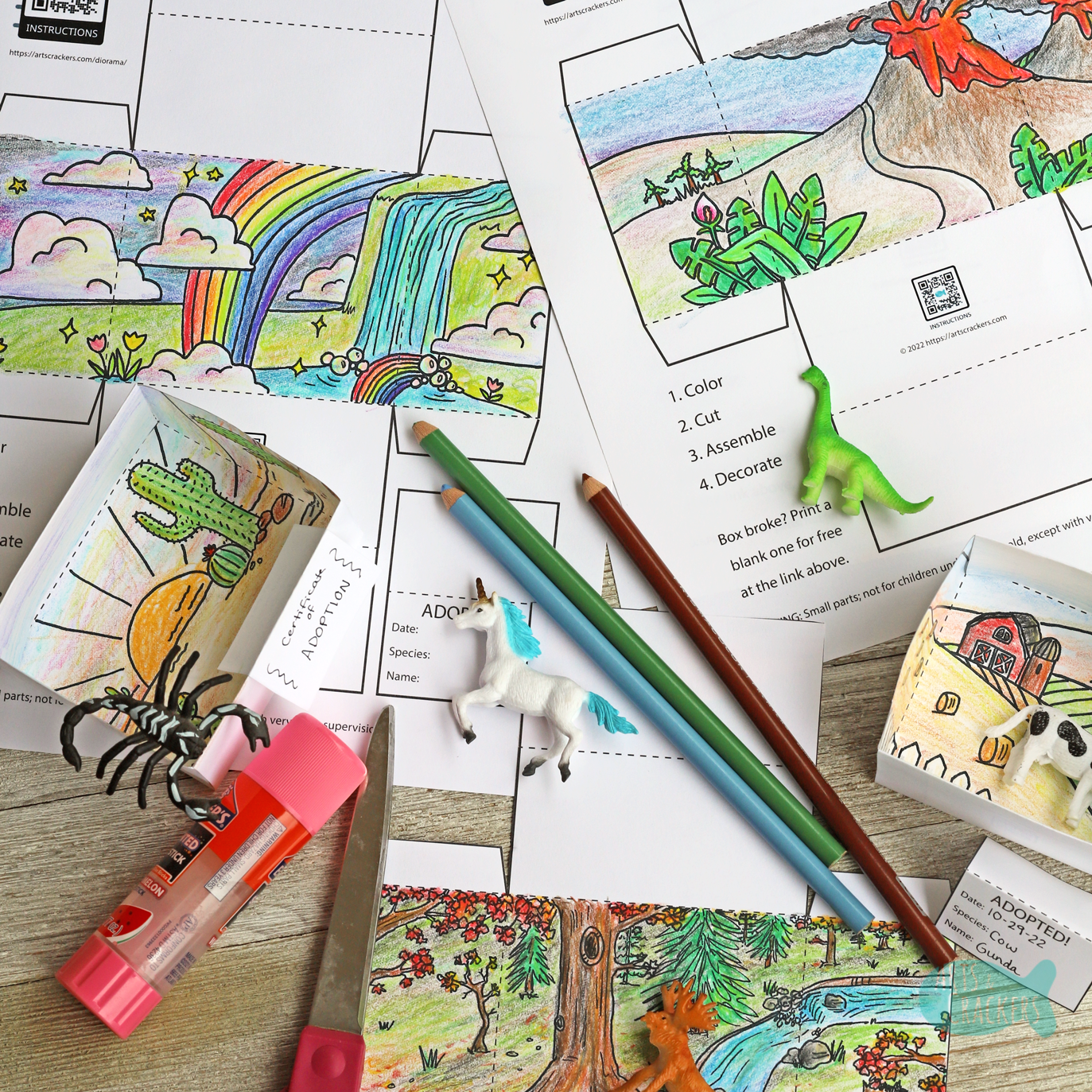
>>>Read more about our 3D Printable Animal Habitat
Dioramas here<<
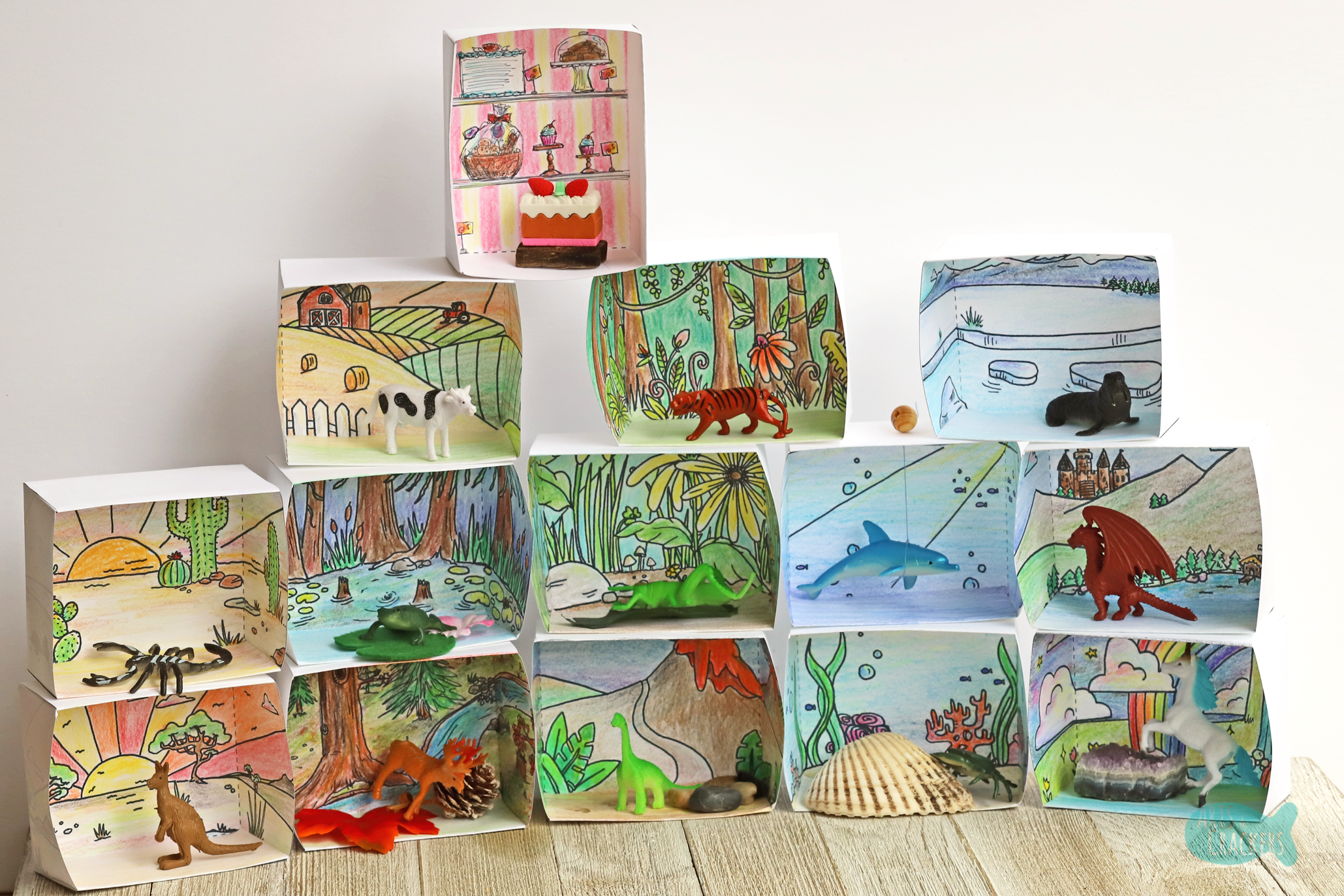
Diorama Crafts For Small Worlds
Check out our collection of paper diorama projects for kids, including habitat dioramas as well as fun themes like the circus or the beach. We've also featured some items you can make for your diorama like people, animals, miniature hats, trees, plants, and historical structures.
Small world play is my favourite type of play because for the most part she can do it independently and it provides so many opportunities for learning, many of which are self initiated. Small world play is great for language development, fine motor skills and cognitive skills as she move pieces around and acts out different scenarios she comes up with. We also usually combine small world play with sensory elements such as water, playdough, dried food {cous cous, rice, pasta}, fake grass, stones, or sand to add a textural element and engage even more senses.
Rainforest Diorama
Learn all about tropical rainforests and the animals that live in this habitat by making this exciting shoebox diorama
Browse Diorama Crafts
3D Paper Tree
African Savanna Diorama
Box Zoo
Clothespin Farm Animals
Community Helper Paper Dolls
Coral Reef Diorama
Dinosaur Diorama
Diorama Plants and Trees
Folding Paper Zoo Animals
Garden Diorama
Mini Beach
Paper Circus Tent
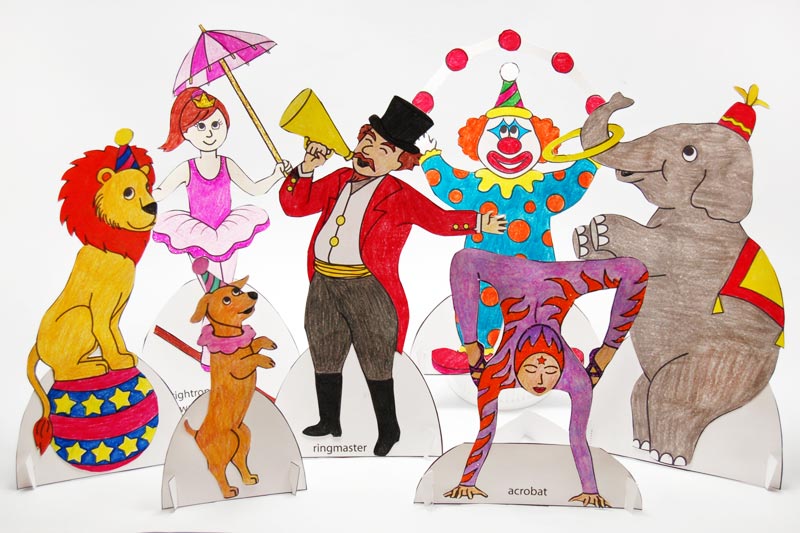
Paper Teepee
Pet Diorama
Polar Habitat Diorama
Rainforest Diorama
Standing Paper Animals
Standing Paper Dinosaurs
Related Categories
Animal Printables
Animal Crafts
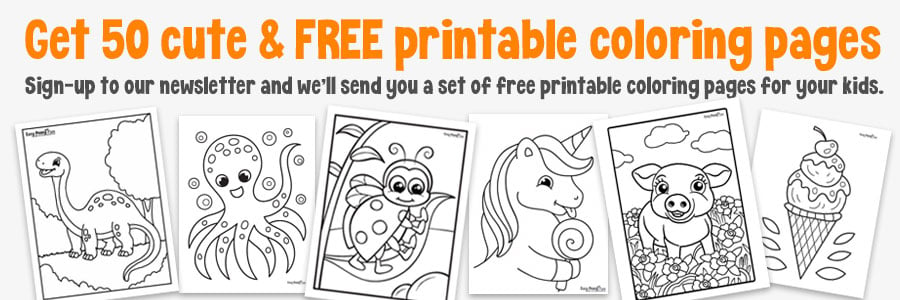
Get the 50 Free Printable Coloring Pages
Signup for news and updates from Easy Peasy and Fun, and we will send you a link to get these coloring pages. If you have an active Easy Peasy and Fun membership, you print over 1000 coloring pages for making small world backgrouds and components.
Bins and Boxes Small World Zoo Scenery
Creating a shoebox animal habitat is a fun and imaginative way to bring the wonders of the wild right into your living room. With just a few simple materials, you can craft miniature worlds that are as educational as they are delightful.
1. Rainforest Retreat
A miniature rainforest habitat complete with a toy jaguar and verdant foliage.
I adore the lush, vibrant feel of a rainforest habitat. This is just one of many creative shoebox project ideas you can build. You can create this by lining the shoebox with green construction paper and adding twigs and moss for that authentic jungle look. A small toy jaguar or parrot can really bring the scene to life.
You might like:
Green Construction Paper: Vibrant green construction paper to line the shoebox and create a lush rainforest background.
Artificial Moss and Twigs: Realistic artificial moss and twigs to provide authentic jungle textures and depth.
Toy Jaguar or Parrot: A small toy jaguar or parrot to add life and realism to your rainforest habitat.
2. Desert Oasis
Transform a shoebox into a serene desert oasis with clever crafting.
The desert habitat is all about simplicity and subtlety. Use sand-colored paper to line the box and add small rocks or pebbles to mimic a desert landscape. A little cactus made from green pipe cleaners can be the perfect touch of whimsy, or you could add some cute air dry clay animals.
Some ideas to consider:
Sand-colored Craft Paper: Versatile and easy-to-use paper to line your shoebox and create a realistic desert base.
Miniature Natural Rocks and Pebbles: These small rocks and pebbles add texture and dimension to your desert habitat project.
Green Pipe Cleaners: Perfect for crafting DIY cacti, adding a whimsical element to your desert scene.
3. Arctic Adventure
An arctic habitat that sparkles with icy wonder and charm.
For a chilly arctic habitat, cover your shoebox in white felt to resemble snow and ice. Add a toy polar bear or penguin to capture the essence of the polar regions. For a more hands-on approach, you can explore these air dry clay animal ideas. My personal touch is to sprinkle a bit of glitter for that frosty sparkle.
A few things you might like:
White Felt Sheets: These white felt sheets are perfect for creating a snowy base in your Arctic habitat project.
Polar Bear Toy Figure: A realistic polar bear toy figure to add an authentic Arctic touch to your shoebox project.
Craft Glitter: Add a frosty sparkle to your project with this easy-to-use craft glitter.
22+ Creative Make Believe Stuffed Animal Ideas
16+ Creative Penguin Craft Ideas for Kids
20+ Creative Dramatic Play Ideas for Toddlers
4. Savanna Safari
Capture the spirit of the African savanna with this creative shoebox display.
Bring the vast savanna habitat to life with golden paper and tufts of straw. A plastic or cardboard elephant or lion can roam freely, or you can make your own with these fun clay animal ideas. I love adding a few acacia trees made from brown and green paper for authenticity.
May just do the trick:
Plastic Safari Animal Figurines: A set of small plastic animal figurines including elephants and lions to bring the savanna scene to life. Ideal for educational projects and imaginative play.
Golden Craft Paper: Golden craft paper suitable for creating the savanna floor and backdrop. Enhances the realistic look of your shoebox habitat project.
Craft Straw Bundle: A bundle of craft straw to mimic the dry grass of the savanna, adding texture and realism to your project.
Brown and Green Construction Paper: Colored construction paper for making acacia trees and other vegetation commonly found in the savanna.
5. Coral Reef Wonder
Experience the vibrant underwater world of a coral reef in a shoebox.
Dive under the sea with a coral reef habitat by using blue paper for water and colorful clay for coral. Fish figurines or other cute clay animal ideas can swim amongst the coral for a lively underwater scene. I enjoy using real shells for an extra splash of realism.
A few suggestions:
Blue Craft Paper: Blue craft paper is ideal for creating a realistic underwater backdrop, mimicking the ocean’s depth.
Colorful Modeling Clay: This clay allows you to model vibrant coral pieces, adding color and life to your shoebox habitat.
Miniature Fish Figurines: These figurines will make the coral reef come alive, swimming among the crafted corals.
Real Sea Shells: Use authentic sea shells to enhance the realism of your coral reef habitat.
Sand or Gravel: Sand or gravel is perfect for creating a realistic sea bed for your coral reef scene.
6. Mountain Retreat
A miniature mountain retreat with majestic peaks and wildlife.
Craft a mountain habitat with gray paper and jagged styrofoam peaks. A toy mountain goat or eagle can add life to this rugged landscape. For a fun DIY alternative, try making some cute and easy clay animals. I like to dab a bit of white paint for snowy mountain tops.
Give these a look:
Gray Craft Paper: Perfect for creating realistic mountain textures, this gray craft paper is versatile and easy to work with.
Styrofoam Blocks: Lightweight and easy to cut, these styrofoam blocks help build dramatic jagged mountain peaks.
Toy Mountain Goat: Add life to your mountain habitat with this realistic toy mountain goat figure, perfect for educational displays.
White Acrylic Paint: Use this high-quality white acrylic paint to dab snow onto the mountain tops, adding a realistic touch.
7. Wetlands Wonderland
Step into the tranquil world of wetlands with this shoebox creation.
Recreate a wetlands habitat with earthy tones and small water features. Use blue cellophane for water and add reeds and lily pads from paper. A toy frog or duck can complete this serene marshland scene, or you could create your own with these stuffed animal sewing patterns.
Maybe worth checking out:
Blue Cellophane Sheets: These blue cellophane sheets are perfect for creating realistic water effects in your wetlands habitat project.
Artificial Reeds and Lily Pads: Add authentic touches to your project with these lifelike artificial reeds and lily pads.
Plastic Frog Toy: Enhance your wetlands scene with a realistic-looking plastic frog toy.
8. Forest Hideaway
A lush forest habitat teeming with life and natural elements.
A forest habitat is perfect for showcasing nature’s beauty. Cover the shoebox with dark green paper and add twigs and leaves for depth. If you enjoy projects like this, you might also like these cute clay animal planter ideas. I like to include a toy deer or owl to inhabit this leafy retreat.
Items that may come in handy:
Dark Green Craft Paper: Perfect for creating a lush, forested backdrop in your shoebox habitat.
Artificial Leaves and Twigs: Adds realistic depth and texture to your forest habitat project.
Toy Deer or Owl Figure: A realistic animal figure to inhabit the forest scene, enhancing the project’s visual appeal.
9. Tundra Trek
Explore the barren beauty of the tundra with this captivating shoebox scene.
The tundra habitat is all about stark beauty. Use white and gray paper to mimic the tundra’s icy landscape and include cotton balls for snow patches. Similar to creating a habitat in a box, designing a pet’s home can be a fun project—check out these guinea pig cage ideas for inspiration. A toy arctic fox or hare can add a touch of wildlife intrigue.
Some handy options:
White and Gray Craft Paper: High-quality white and gray craft paper suitable for mimicking the icy tundra landscape.
Cotton Balls: Soft cotton balls perfect for creating realistic snow patches in your tundra habitat.
Arctic Fox or Hare Toy Figure: A realistic arctic animal toy to add wildlife intrigue to your project.
10. Jungle Journey
A vibrant jungle habitat bursting with life and greenery.
Create a dense jungle habitat with layers of green paper and hanging vines. Add small toy monkeys or birds to swing through your creation. Keeping all your craft supplies and toys organized can be tricky, so take a look at these clever dog toy storage ideas for some tips. I love using real leaves for a touch of authenticity and texture.
Check if these fit your needs:
Green Craft Paper Set: A variety of green craft papers ideal for creating a layered jungle effect in your habitat project.
Artificial Hanging Vines: Realistic hanging vines to add depth and authenticity to your jungle habitat.
Small Toy Monkeys: Adorable toy monkeys perfect for animating your jungle scene with playful characters.
11. Urban Wildlife
Discover the fascinating world of urban wildlife with this creative setup.
Explore the concept of urban wildlife by using gray paper for concrete and adding small plants. This is just one of many creative shoebox project ideas you can try. Include a toy raccoon or pigeon to bring this city scene to life. I enjoy adding tiny cars or buildings for a playful urban touch.
A few choices to try:
Miniature Toy Raccoon: A small, realistic toy raccoon to add life and character to your urban wildlife habitat project.
Model Trees and Plants: A set of small artificial plants and trees to simulate greenery in your city-themed habitat.
Gray Craft Paper: Gray paper to create a concrete effect, perfect for crafting an urban environment.
Small Model Cars: Assorted miniature cars to add a playful urban touch to your shoebox habitat.
Miniature Building Models: Small building models to create a realistic cityscape.
12. Ocean Depths
Dive into the mysterious depths of the ocean with this imaginative shoebox project.
For an ocean habitat, use various shades of blue paper for depth and waves. Add your own cute air dry clay animals like dolphins or sharks to swim through the deep blue. I like to sprinkle small pebbles to imitate the ocean floor.
Consider these options:
Assorted Blue Craft Paper: Craft paper in various shades of blue to create the illusion of ocean depths and gentle waves.
Small 3D Toy Marine Animals: Miniature toy dolphins and sharks that can be used to simulate marine life in your habitat.
Decorative Pebbles: Small pebbles to mimic the ocean floor, adding texture and realism to your project.
13. Swamp Mystery
Unearth the enchanting mystery of a swamp with this inventive project.
A swamp habitat is a mix of mystery and nature. Use dark green paper for murky water and add reeds and moss. A toy alligator or turtle—or one you craft using these air dry clay animal ideas—can create an intriguing swamp atmosphere.
These products might be useful:
Dark Green Construction Paper: Perfect for creating a murky water effect in your shoebox swamp habitat.
Artificial Reeds and Moss Set: Ideal for adding realistic swamp vegetation like reeds and moss.
Toy Alligator or Turtle: A small creature model to enhance the mysterious swamp atmosphere.
14. Prairie Panorama
Experience the vast and beautiful prairie landscape with this shoebox creation.
Capture the wide-open feel of a prairie habitat with golden straw and paper. Add a toy bison or prairie dog for authenticity. If you enjoy crafting, explore these creative clay animal ideas to make your own. I find that a few paper flowers can add a lovely touch of color.
Useful items to consider:
Toy Bison Figure: A realistic bison toy figure to enhance the prairie habitat and add authenticity to your project.
Wooden Shoebox: A sturdy wooden shoebox as the perfect foundation for building your prairie habitat.
Artificial Straw and Flowers Set: A set of artificial straw and colorful flowers that can add texture and vibrancy to your prairie display.
15. Rainforest Canopy
Explore the vibrant canopy of the rainforest with this elevated shoebox habitat.
Elevate your rainforest habitat by focusing on the canopy. Use various shades of green paper and dangling vines for a layered effect. A cute clay animal like a parrot or tree frog can add a splash of color and life.
Possibly helpful picks:
Green Craft Paper Variety Pack: A collection of green craft paper in various shades to create a layered rainforest canopy effect.
Artificial Hanging Vines: Realistic hanging vines to add depth and authenticity to your rainforest canopy project.
Colorful Toy Parrot: A vibrant toy parrot that adds a splash of color, enhancing the liveliness of your rainforest habitat.
16. Coral Lagoon
Dive into the colorful world of a coral lagoon with this dazzling creation.
Bring a coral lagoon habitat to life with vibrant clay corals and blue cellophane water. In addition to the corals, you can add cute and easy clay animals like sea turtles or fish for an active underwater scene. I love adding real coral pieces for an authentic touch.
Explore these options:
Colorful Clay Set: A vibrant clay set perfect for crafting realistic coral pieces. Ideal for adding a pop of color to your shoebox habitat.
Blue Cellophane Sheets: Translucent blue cellophane to mimic ocean water. Easy to shape and cut to fit your habitat design.
Mini Sea Animal Figures: A set of miniature sea animals like turtles and fish to enhance the underwater scene.
Natural Coral Pieces: Real coral fragments for an authentic touch in your lagoon habitat. These add texture and a realistic feel to the project.
17. Bamboo Forest
Step into the tranquil world of a bamboo forest with this imaginative shoebox project.
Create a bamboo forest habitat using green straws or paper tubes. Add a toy panda or red panda to roam this serene environment. For a different kind of project, you could also try one of these stuffed animal sewing patterns. I enjoy incorporating real bamboo leaves for that extra touch of nature.
Possibly handy products:
Green Paper Straws or Tubes: These green paper straws or tubes imitate bamboo stalks, perfect for creating an authentic bamboo forest landscape.
Toy Panda or Red Panda Figure: A realistic toy panda or red panda to add to the habitat, bringing the scene to life.
Artificial Bamboo Leaves: Use artificial bamboo leaves for a natural look that enhances the realism of your project.
18. Savanna Waterhole
Capture the essence of a savanna waterhole with this detailed shoebox project.
Focus on the savanna waterhole by creating a small pond with blue paper and adding toy zebras or giraffes. Surround it with straw and small rocks for authenticity. If you’re creating a habitat for a real pet, you might also like these guinea pig cage ideas. I find that a few paper trees can complete the scene perfectly.
Might be a good match:
Toy Animal Figurines Set: Include realistic toy zebras and giraffes to enhance the authenticity of your savanna waterhole project.
Blue Craft Paper: Use blue craft paper to create a vibrant pond, adding a splash of color to your project.
Miniature Trees for Crafts: Add a touch of realism to your habitat with miniature trees, perfect for completing the savanna scene.
19. Temperate Forest
Explore the vibrant life of a temperate forest with this engaging shoebox display.
A temperate forest habitat is one of many classic shoebox project ideas and can be created with brown and green paper and twigs. Add toy squirrels or birds for a lively forest scene. I like to use real acorns for an added touch of nature.
A few relevant products:
Brown and Green Craft Paper: This set of craft paper in earthy tones is perfect for creating a realistic forest backdrop in your shoebox habitat project.
Miniature Woodland Animal Figurines: A collection of small squirrel and bird figurines to enhance the authenticity of your forest scene.
Artificial Acorns and Pinecones: These realistic artificial acorns and pinecones add a natural touch to your project, without the worry of spoilage.
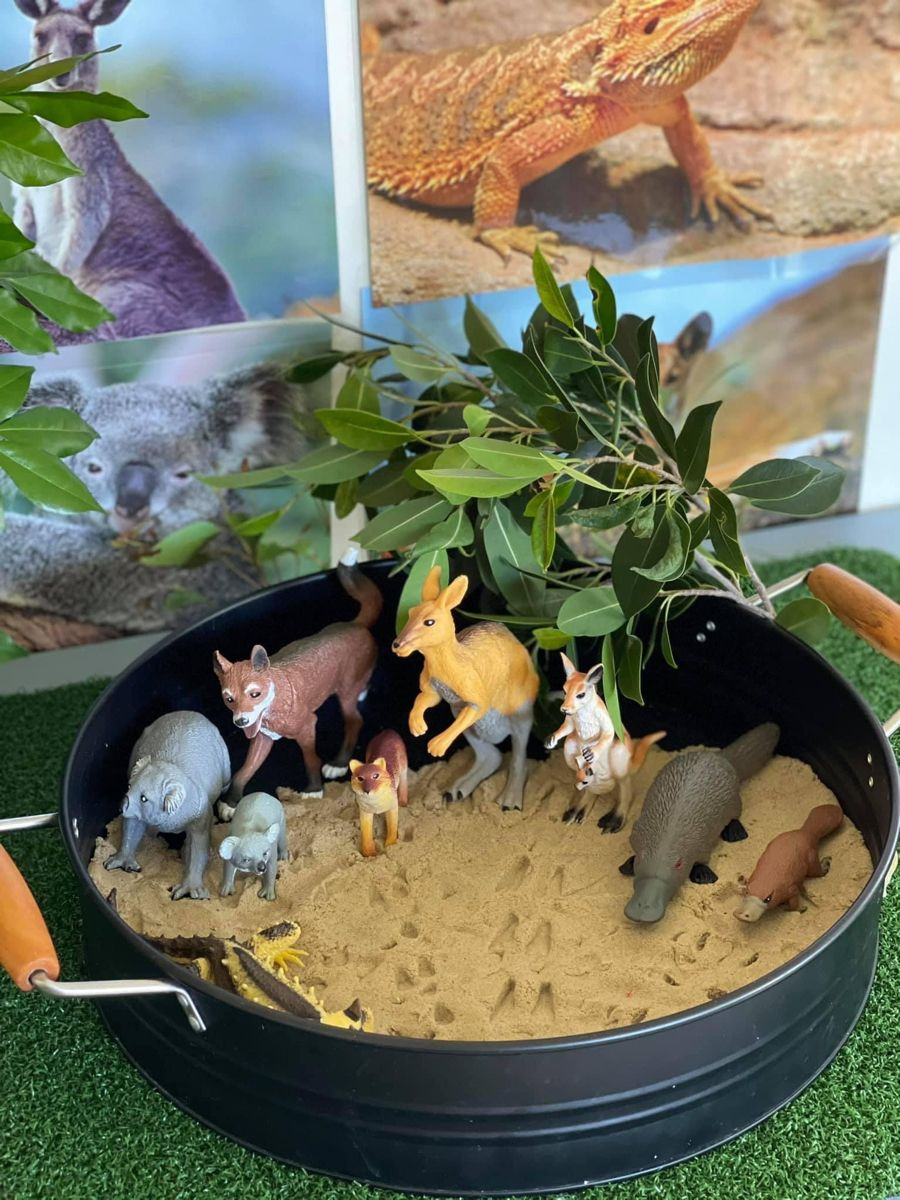
Science Themed Small World Play
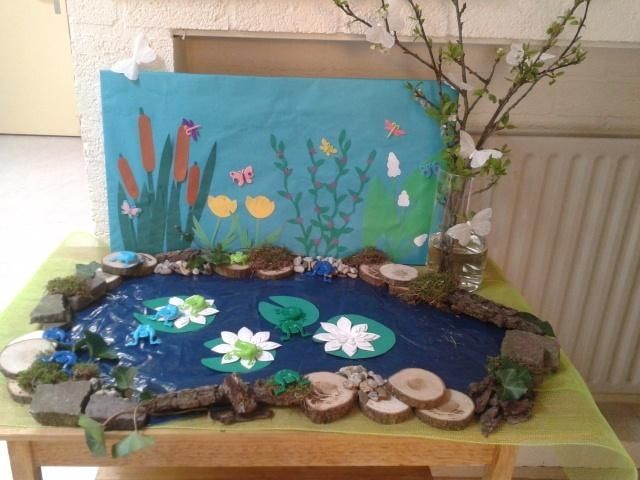
Science-themed small world play can be built around themes like space exploration, dinosaur lands, and ocean ecosystems, using a variety of materials. For space, use a dark base with "stars" and planets; for dinosaurs, use dirt, rocks, and small plants to create a swampy environment with toy dinosaurs; and for the ocean, create a beach or underwater scene with sand, water, or blue felt and sea creature toys. You can also incorporate science experiments like using playdough for a "volcano" or adding a fizzy science twist to an ocean theme.
Found it here >> Premeditated Leftovers
What a great idea! Take your budding engineer outside and help him set up an outdoor train table using some flower planters.
Find a container, or your old red wagon, fill it with sand and make a pirate garden for your Playmobil figures!
Found it here >> Premeditated Leftovers
What a great idea! Take your budding engineer outside and help him set up an outdoor train table using some flower planters.
Found it here >> Play Trains
Or go on a safari expedition in an oversized container.
Found it here >> Puzzles Family Daycare
Found it here >> Happy Hooligans
Warning! Construction Small World Fun Ahead
-Physics & Engineering
Oh, what fun your little construction fan is going to have with these wonderful construction small World bins. We really “dug around” until we found the best bins out there.
We just love bins as they lend themselves to so much open-ended play. Imaginative play is essential for learning and sensory bins are very engaging and kids just love them.
Let your little worker help build your bin or surprise them by having one ready to go. Either way these 12 construction bins are winners and will give you a lot of fun ideas.
This article is part of our activities for boys series. You are going to love these bins!
Goodnight Construction Site is a wonderful book and this bin idea includes a story and a bin. So cute! The truck even has a blanket!
What I like about this easy construction bin is that they added chocolate playdough for mud! Super idea.
This one has moon sand in it. Have you ever played with moon sand? They did it outdoors (and I would too!) They kindly included a recipe for moon sand as well. Men at Work Construction Zone
What I like here is that they did some construction while creating their bin for added play value. They built a small pond with a bridge and a tunnel. Both were very easy and I’m sure her boy enjoyed making them and yours would too.
The signs in this bin are what drew me to it. They are free printables so you can make your own. I bet your boys are really going to like having signs for their play ideas. They also have this set up as a gift to give. Neat idea! Construction Bin Gift Idea.
Here is one using potting mix as a base. There are some good bark pieces in there that would be great for constructing.
Two great construction bin ideas are found on Elemeno-p Kids. There is one bin with kinetic sand and one with beans. I really like the kinetic sand idea because it molds and moves which is an added engaging feature.
I found a very clever idea. She took a cardboard box and cut part of it down so you could get your hands in to play. She then painted a background on the box and added a scene. She also put plastic down in the bottom of the box to contain the sand. Construction Site Diorama. Brilliant.
Using sand and grains together along with some rocks and dowel rods this construction site sensory play idea looks like a lot of fun. I love that she added a construction hat – nice touch.
For an unusual filler, try coffee grounds. If you have a sensitive boy I would make sure he is ok with the smell before making this. This is a pretty neat idea. Coffee grounds look just like dirt but are pretty easy to clean up.
This neat construction bin is a winner. It has a lot of great features including sand, little logs, rocks, and even a few construction figures. I can see kids playing with this one for a long time.
Fix up a bin that will work great for your child. Mix things up, take an idea from one and combine it with another. Make your own unique bin that he will really enjoy playing with.
Set one up as a surprise or enlist their help in creating the perfect bin. They will likely have some wonderful ideas of what to add and an opinion on how it should look!
Kids love playing with construction trucks and building blocks, so why not combine the two together?!
They roll the trucks through the sand or rocks, fill the dump truck, make lots of noises while driving the loud equipment, all while pretending to run their own job site!
C is for Construction Site
I want to show you how easy it is to build 2 different types of construction sensory bins, all while using the same toys!
First, I made a construction site sensory bin using kinetic sand. I loved making this sensory bin with sand because it’s very realistic. I love how kinetic sand flows and is moveable. This makes it easy to play with and manipulate. Stack it, pour it, scoop it!
Next, I took all the sand out of the box, and used a big bag of mixed dry beans! You can find these in the bean aisle of any grocery store. The dry beans add a different element to the construction sensory bin. It makes driving the construction vehicles seem more “bumpy” and the beans can be used as imaginary rocks or pebbles on the job site.
Whether you use sand or mixed beans, your construction site sensory bin is sure to be a hit!
What else did we use in our construction site?
We used the wooden blocks from this Angry Birds Knock On Wood Game
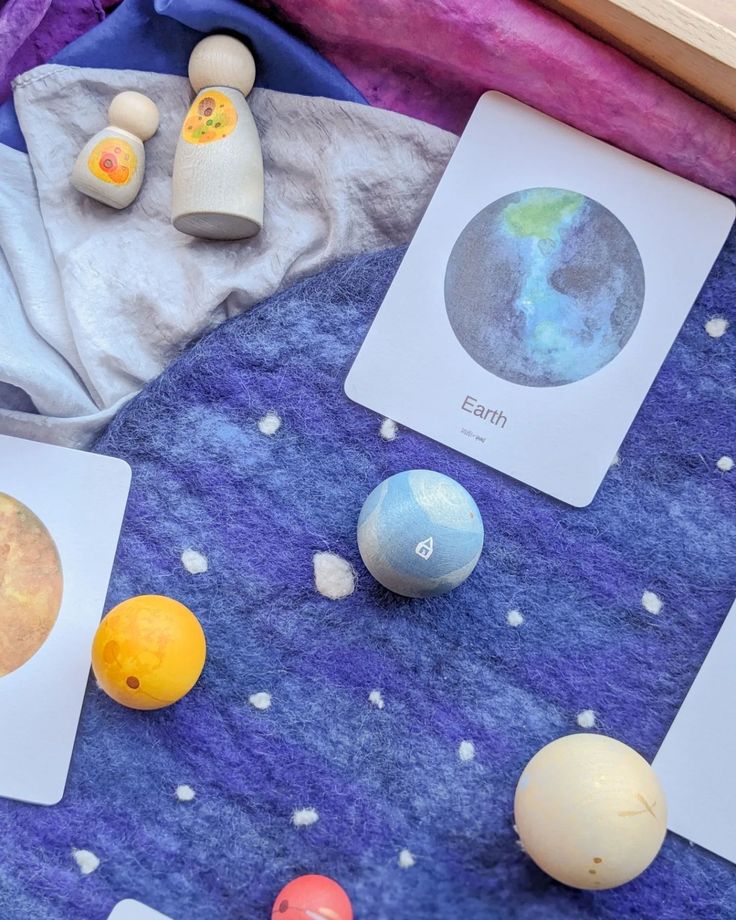
Space
Base: Dark-colored felt or fabric.
Materials: Small pom-poms for planets, glow-in-the-dark stars, aluminum foil for rockets, and toy astronauts.
Activities: Role-play a moon landing or explore distant planets.
Dinosaur land
Base: A shallow container filled with dirt, sand, or dry beans.
Materials: Rocks, small branches, and green felt to represent plants. Use brown playdough to create mud or a swampy area. A volcano can be made from recycled packaging and covered with crumpled paper.
Activities: Create a prehistoric landscape, have toy dinosaurs interact, and add books about dinosaurs for inspiration.
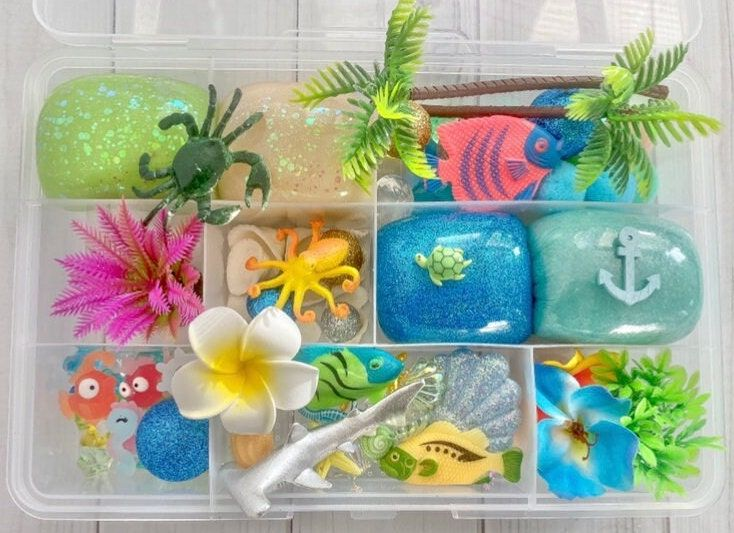
Ocean and beach
Base: A large bin or tray.
Materials: Sand, blue playdough, small pebbles, and water. Use blue cellophane or fabric for an underwater effect and add toy sea creatures.
Activities: Build sandcastles, create a rocky shore with playdough, or add a "fizzy science twist" by adding baking soda to the water and using vinegar in a small container to create a small eruption.
Other science themes
Arctic: Use fake snow, cotton balls, and small animal figures like polar bears and seals to create an icy habitat.
Weather: Use cotton balls for clouds, blue felt for rain, and yellow pom-poms for the sun to create a weather-themed world.
Camping: Use a dark felt base, twigs for trees, and small toy animals to create a forest setting.
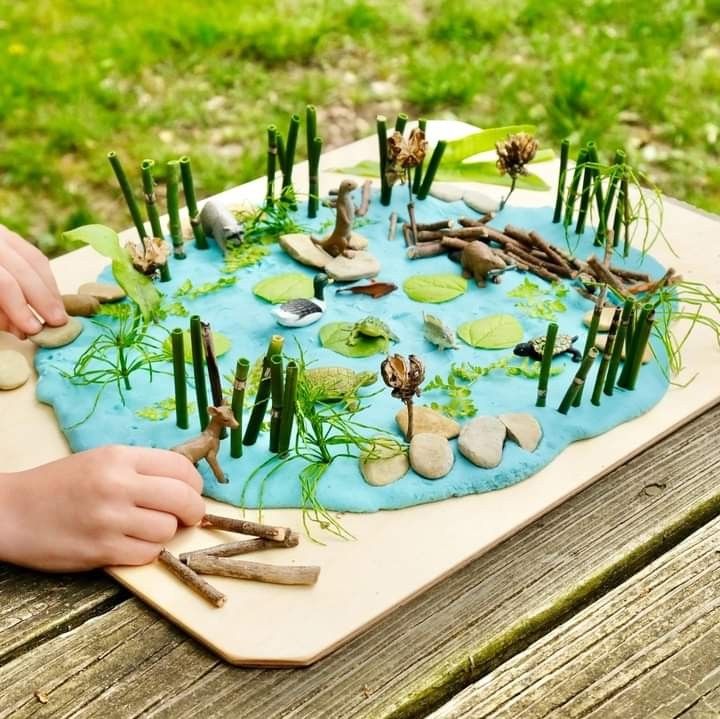
Tips for setup
Use natural materials: Incorporate natural elements like rocks, sticks, and leaves to create a realistic environment.
Incorporate science experiments: Integrate simple science experiments directly into the play. For example, create a "sink or float" activity by adding various objects to water.
Add other learning materials: Include related books, writing prompts, or fact cards to extend the learning experience.
Allow for creativity: Encourage children to add their own ideas and materials to the scene.
Small world play develops science skills such as observation, problem-solving, classification, and prediction. By manipulating objects, children practice experimentation, noticing cause-and-effect, and developing spatial reasoning as they build their small worlds.
Core science skills
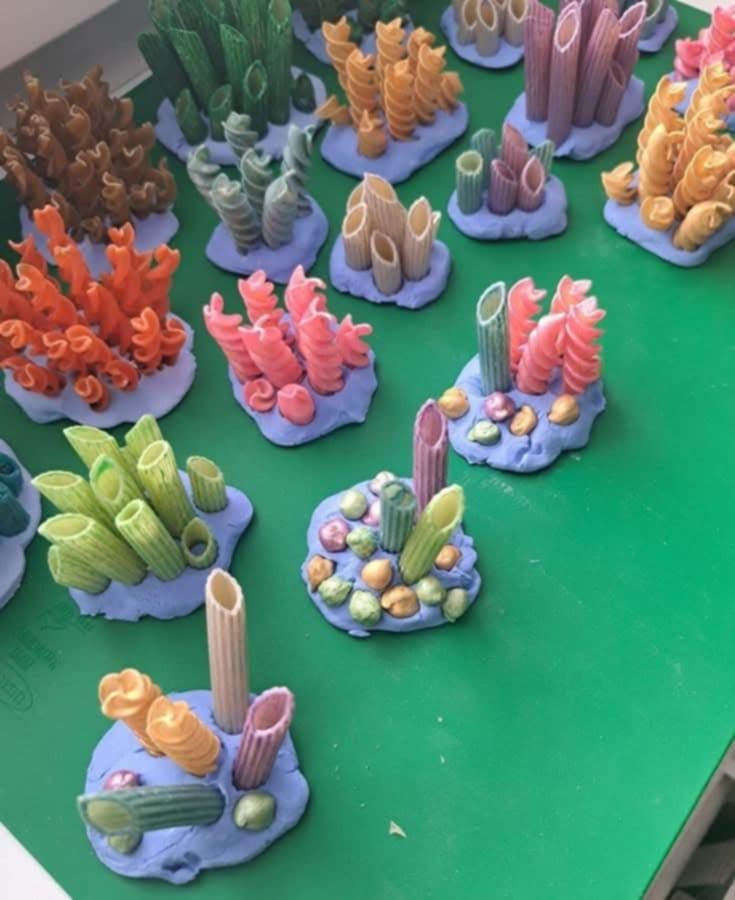
Observation: Watching and noticing how the small world components interact is a fundamental science skill.
Problem-solving: Children naturally experiment and use trial and error to overcome challenges in their play, like how to get a character across a river or stack blocks to build a tower.
Cause and effect: They learn that actions have consequences, such as pushing a car causes it to move or dropping a rock into water causes it to splash.
Prediction and inference: When a child places a figure in a certain spot, they are predicting what will happen. They make inferences based on their observations, for example, "The car can't go there because the path is blocked".
Classification and sorting: Children group items based on their characteristics, like putting all the animals together or sorting them by size.
Measurement: They can practice simple measurement by comparing sizes, like how many blocks tall something is.
How small world play fosters these skills
Physical manipulation: Picking up, moving, and arranging small objects develops fine motor skills and hand-eye coordination, which is essential for detailed work in all sciences.
Creating and testing hypotheses: When building a scenario, a child might hypothesize that a bridge will hold a figure. If it collapses, they have a new data point to test with their next attempt.
Storytelling: Creating narratives helps children process and communicate their ideas, which is a key part of the scientific process.
Exploration: The act of playing is a form of scientific inquiry, where children explore how things work by doing, touching, and experimenting firsthand.
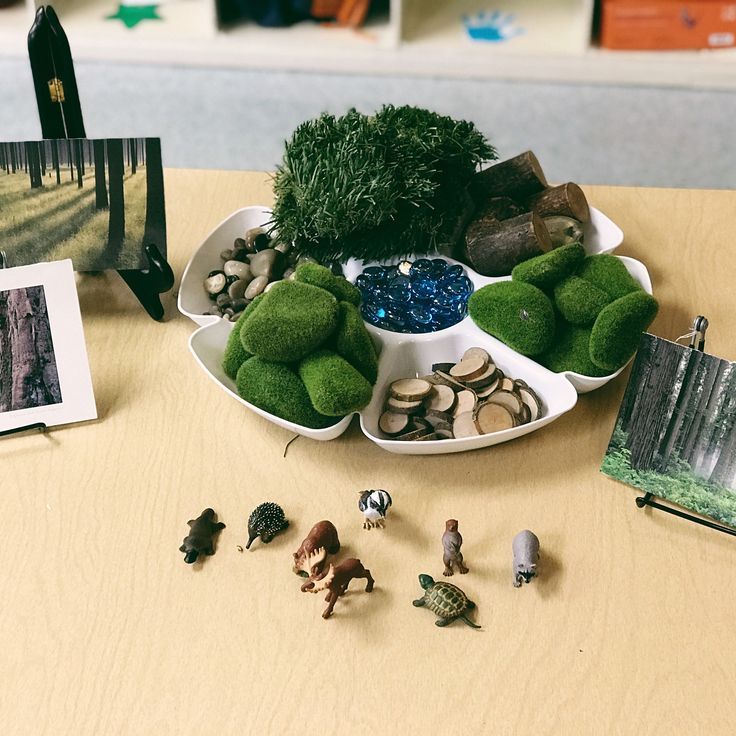
Small world play teaches about habitats by using miniature toys and natural materials to create different environments like forests, oceans, or deserts. Children can learn by building these scenes, making decisions about what each animal needs (like food, water, or shelter), and acting out scenarios to understand how different living things are adapted to their specific homes.
This video demonstrates how to create different habitats for small world play:
April's Toy World-YouTube • Mar 16, 2024
Ideas for creating habitats
Ocean: Use blue kinetic sand or slime, pebbles, and aquarium plants to create a water environment. Add small fish and sea creature figurines.
Forest: Use green pebbles or moss for the ground, small trees or branches, and rocks to build a forest. You can add woodland animals or even mythical creatures.
Desert: Use kinetic sand, rocks, and small cactuses to represent a dry, desert landscape. Add desert animals like scorpions or lizards.
Farm: Use kinetic sand, green grass, and fencing to create a farm. Include figurines of farm animals like cows, pigs, and chickens.
Dinosaur: Create a prehistoric world with lava rocks, a volcano, and palm trees. Place dinosaur figures in this environment.
You can also watch this video for more ideas on creating animal habitats:
April's Toy World- YouTube • Jul 19, 2025
How to facilitate learning
Start with a theme: Choose a habitat you want to build, like a zoo or rainforest.
Incorporate natural materials: Use items like pinecones, sticks, and rocks to add realism and sensory exploration.
Use open-ended materials: Provide blocks or other building materials so children can create their own structures and pathways.
Ask questions: Encourage critical thinking by asking what each animal needs to survive in its specific habitat. For example, "Does this lion need more space than this mouse?".
Tell stories: Have children create and tell stories about what their animal figures are doing in the habitats to build their narrative and verbal skills.
This video shows how to use small world play to teach children about animal habitats:
April's Toy World- YouTube • Jun 22, 2024
for babies, toddlers and preschoolers
(Hands-On & Montessori-Inspired)
Ways To Use Animals Figurines for Learning
I was at Micheal’s when I overheard a woman say to her daughter ” I just don’t get what people use these for.” As she grabbed a Safari Toob. I couldn’t help it, I yelled down the aisle, ”As a preschool teacher I use animal figurines in a million ways!” Which was only a slight exaggeration, and named a few animal learning activities. On the way home I thought she must not be the only person who wonders what animal figurines are good for so I complied a list of my ten favorites ways to use animal figurines for animal learning activities in your preschool classroom, but you can do these activities at home too!
Animal Learning Activities with Animal Figurines but in my class, a favorite is to add farm figurines to play dough along with some toothpicks and let the children create barnyards. Another favorite is to make prints in the snow ( white play dough).
Use them for sorting, we did this a lot at preschool, and we didn’t use anything special, we just dumped the basket of animal figurines and groupings would slowly emerge. Sometimes we’d count things, arrange them by size or color. This is probably one of my favorite things to do!
Use them for more specific classifying lessons like deciding if an animal is a domestic pet or a wild animal. The lines aren’t always clear but being able to manipulate and hold the figurines helps to bring this activity to life.
Freeze some water and make your own mini Arctic by adding in arctic animal figurines. This is easily one of the most played with items I have ever made for a classroom.
Use the figurines for circle time; this animal sounds game is always a hit!
Use the figurines to prompt storytelling!
How do you use figurines in your classroom or at home for learning?
Fun and Educational Ideas for Toob Animals
You know the Toob animals, the ones that strangely enough, come in a tube? If you child is anything like mine, they love those little animals! Toobs are great because of the variety of packs available making them great for learning tools. Shhh don’t tell the kids!
We are also a big fan of the Schleich toys, which are generally bigger but beautifully made. If you happen to have a kid who is into Knights then I have a selection of posts HERE
Anyway, back to Toob animals, we have used them for matching with card, learning about continents, different species of penguins, making foot prints… to name but a few!
As I know so many kids love these little toys, I thought a handy round up post of ways to use them would be good…
You can learn while having fun!
1. Classification
You can do this with different types of animals. You just need to make a couple of labels, one for each category you are using. I recommend starting by talking about the categories, for example, vertebrates and invertebrates. Talk about the difference, maybe watch a video or read a book about it and then introduce the work to the shelf.
Basic category ideas:
Vertebrates / Invertebrates
Live on: land /water / both
Mammals / birds / fish /reptiles /amphibians
Can swim / fly
Animals that live in water: fish / mammal / bird
What do they eat: carnivore / herbivore / omnivore
Of course there are many categories and as your child devours the information you may find yourself going deeper and deeper into class, order, family and species!
Sometimes your child might come up with their own ideas, like animals that like/dislike the snow, animals that can/can’t climb trees or animals that can walk on two legs and those who can’t.
You can even play a guessing game as an extension. You put the animals into two groups (don’t tell what the classification is) and the child tries to guess. Then switch and let the child try.
Another extension would be to draw a venn diagram to place the animals in, some animals can swim and walk on land or some eat plants and animals. It makes a nice introduction to venn diagrams as well as animal classification.
2. Habitat Study
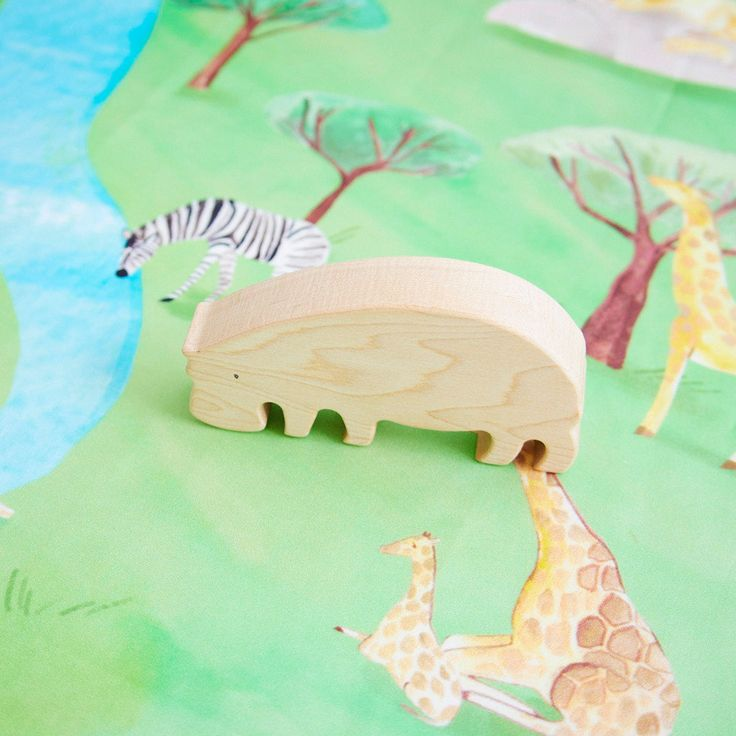
In Montessori children study about each continent, using animals is a great way to get them interested. Placing animals on a map, researching about animal habitat, find out about unusual animals has always been a big hit in our house.
There is a good collection of free animals cards HERE not made specifically for Toob but there is some crossover.
3. Matching
This can be done really simply in the same way you introduce 3 part cards. Once the child has mastered the animal with the image, if the child is ready the match the toy with the word. An extension of this would be to make a little book, drawing a picture of the animal and writing it’s name.
Free cards: If you have my Montessori Inspired Activities For preschoolers book, there are a number of free card sets with the download available in the book.
Here are some more animal toob free cards (check out the sites because they have a lot of other printables available)
Farm animals from Natural Beach Living
Animals of Australia from Imagine Our Life
Coral Reefs from Pinay Homeschooler
Backyard birds form In Our Pond
I also have a set of Galapagos cards HERE
Of course, you can also make your own cards by taking photos of the items in your Toob and then use my free Make Your Own Montessori 3 Part Cards Course!
4. Sensory Fun
Playdoh has to be one of those worldwide sensory experiences that most children love. You can use the toob animals to make tracks in the playdoh. Which animals have similar tracks? Which are different? Why?
You could take this a step further and make plaster casts of the imprints.
Sensory bins are also popular, fill a box with sand, rice, dried pasta or just plain old water. Add some toob animals and anything else that might fit with the theme of the toob and let your child use their imagination. There is no specific outcome, just playing is the learning experience.
The Mystery Bag.
My boy is now 10 and he still loves playing this! Gat a small cloth bag, sneak one toy into it, the child then puts his or her hand in the bag and tried to guess what it is. Simple game but lots of fun and can be played easily with mixed ages..
A great one for the summer if freezing animals in water in a tupperware box. Excavating them is a fun way to keep cool!
5. Free Play
Not everything we provide our kids with should have a specific learning outcome. I am a big believer that free play should be a big chunk of our kids day, they don’t need to be kept busy all the time and they should be allowed to get bored. Just letting your kids do whatever they want (within reason of course) with the toys will build their imagination and allow them to experiment, both of which are great learning skills.
I have found lines of toys right on the edge of the bench, Ebi-kuns self challenge was to line them up as close to the edge as possible.
I have also seen him use the scales and weighing the different animals, trying to see which ones were the same.
More than once a selection of animals have died when he has done the volcano experiment! Aghhh lava.
Other Toobs Available!
I have only talked about animal Toobs here but there are so many available from African villages to dinosaur fossils, to Around The World landmarks (which I secretly have my eye on!) I’m sure whatever your child is into right now, there is a Toob set for them to fall in love with!
.
Now, over to you… Does your child like Toob toys? How does he/she use them? share in the comments.
Schleich African elephant (2011) and Schleich male Asian elephant (2015). My son's favourite figurines :)
I am here today to share with you some ideas for activities with animal figurines. They are one of the best toys you can purchase for your kids. They encouraged my son to learn more about animals, they help him understand and really experience what the differences between the species are. His knowledge about animals is huge, he not only can name and recognize a few hundreds of them but also knows where they live, what they eat (only herbivore at the moment), can name their body parts. I know that the figurines and some of the amazing books that we own helped him to really research the topic.
I categorized the activities into three groups: beginner friendly,intermediate and advanced. Now, this is only to guide you, all kids develop slightly differently, so please do not feel bad if your kid didn't master one of the skills mentioned yet.
All of the activities are very engaging, most of them are hands-on and Montessori-inspired (presented slightly differently than the standard on the tray Montessori way).
I hope you enjoy reading and try some of these activities out 😊
BEGINNER FRIENDLY ACTIVITIES:
Giraffe: Schleich (1998)
DISCOVERY BASKETS
A discovery/treasure basket is a basket filled with items that your child is welcomed to explore with all his senses. When choosing the animals, please ensure that they don't have sharp parts that could hurt your baby. This giraffe is just perfect, it has some weight to it, but it isn't as heavy as some of the animals we own, for instance the elephants (Schleich), the musk ox (CollectA) or the mammoth (Schleich) that you will see on some other photos in this guide.
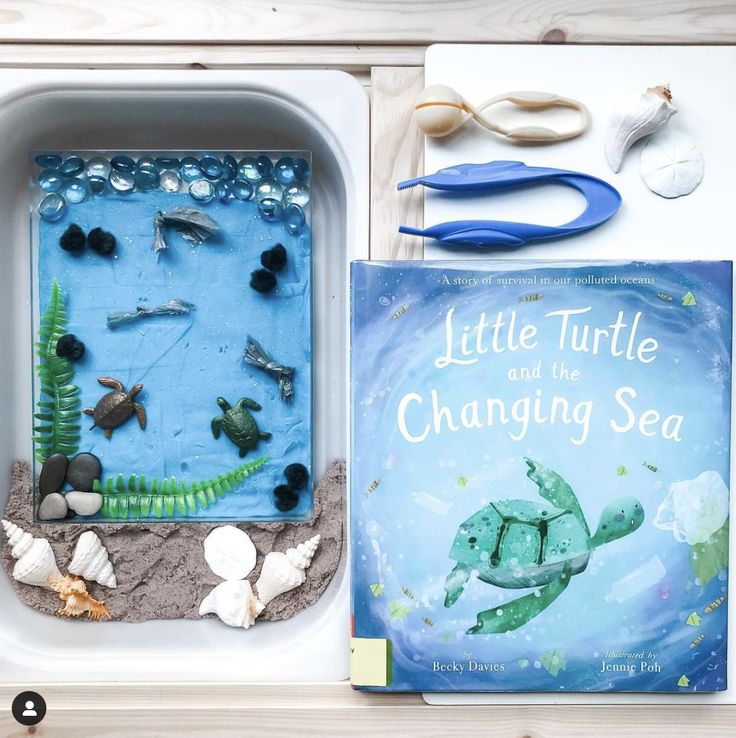
SENSORY BINS
So this is the activity where a parent/ career can be creative. The sensory play is crucial for the child's development because we experience and learn through our senses. It is essential to stimulate them.
Setting up a sensory bin is easy. All you need is a fairly large container (a plastic box/ a pan/ a shoe box / a bowl), some filling (you can use paper shreds, water beads, sand, kinetic sand etc.) and animal figures. You can obviously add some other items if you wish. If you provide your child with a spoon, they can also practice scooping and transferring the animals to a different container. A pair of tweezers or tongs will be fantastic, it will help to develop their fine motor skills. A magnifying glass can help the child to spot characteristics of animals.
If you don't have any of these tools, do not worry. Your child will have so much fun anyway.
The ideas for sensory bins are endless, and because you use the items you already have at home, they are zero cost!
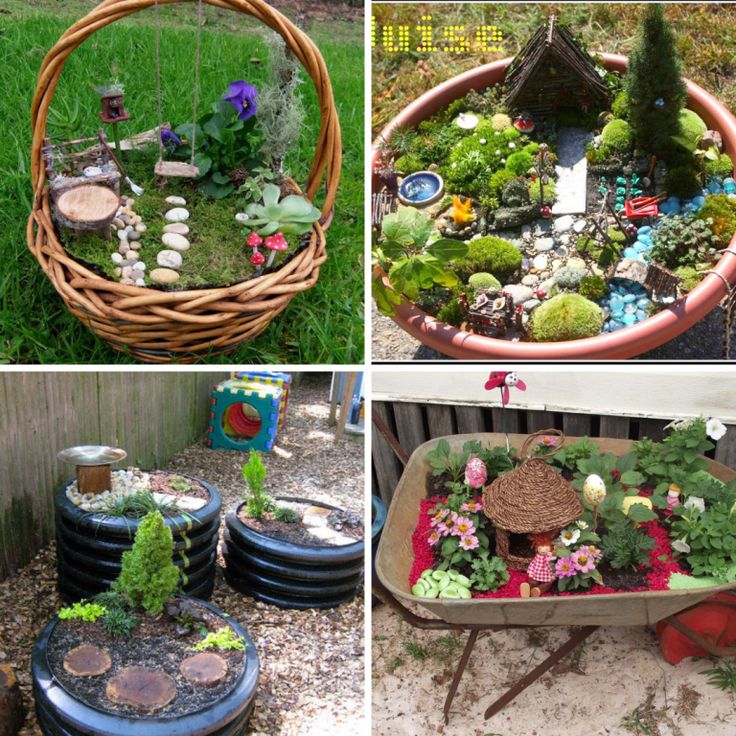
NATURE WALK COLLECTIONS
Depending on where in the world you are, you may be lucky to see different animal species at large. We live in New York, so Kian sees crows, squirrels and foxes on a daily basis, but we won't really see an elephant in his habitat here. Sometimes we take the figurines (one at the time, so Kian can always remember to keep an eye on it) on our nature walks, and it helps my son to visualise how would the real animals look like in their natural environment..
Mandrill female and baby: Schleich (2013)
MATCHING ACTIVITY
Matching is one of the basic math skills, so it is important to practise it. I never thought that it would be so interesting for toddlers and babies, but it really is.
I introduced Kian to matching activities when he was a few months old. He is 2.5 now, and he still loves them. Sometimes, when we read books, he stops me in the middle of the sentence, saying: Mum, wait a moment. I have got a beaver, let me quickly match it!', and off he runs to his shelf, picks the figurines and matches them excitedly.
The book: 'Animal Kingdom' by Steve Parker and Martin Walter; figurines by Schleich - gorilla female and baby (2011), chimpanzee female and baby (2012), chimpanzee baby (2001) , mandrill female and baby (2013), yak
LEARN ANIMALS NAMES AND SOUNDS
This may seem very obvious, but the process of learning new species is endless, simply because not all living animals were discovered and named yet.
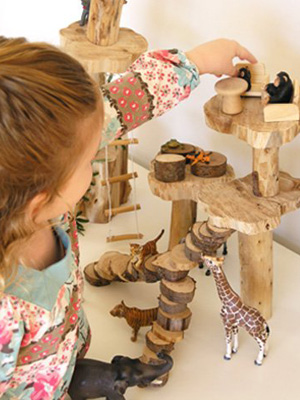
When you realise that your baby is excited any time he sees a particular animal, follow his lead and teach him the name of that animal, and the sound he makes. And then, obviously, you can expose your child to even more words, name what the animal does, or how he looks like. And because when your child is really interested in something, he is in a flow state, he absorbs all the information you give him, he is fully involved and focused. He enjoys the learning process.
You can also use a book about animals to teach your child animal names and sounds. If the photos (and, if possible, seeing the animal in real life) are paired with a figurine, it gives your child a better sensory experience (sight/ hearing /touch).
Musk ox: CollectA (2018; one of my favourite figurines in the collection), the polar bears: Schleich (2011), and the narwhal: CollectA. The book: 'Into The Arctic' Kimberley Faria, Robyn Newton and Amy Oliver
MAKE READING BOOKS FUN
No matter if you read a fiction or non-fiction book to your child, you can make it more fun by tossing in the animals that appear in the book. Try this tip out, especially if your child doesn't like reading books. I believe it will be helpful.
This is a shadow of a Hereford Bull (Schleich 1995).
THE SHADOW PLAY
All you need for the animal shadow play is a dark room, a torch, and some animal figures. You can start off by encouraging your child to guess what animals the shadows belong to, and then make a shadow play theatre. It is entertaining not only for kids but also for the parents :) When Kian was younger, it was a part of our evening routine, and we still do it quite often nowadays.
Rabbit: Schleich (2010), the polars bears: Schleich (2011)
MAKE PLAYDOUGH FOOTPRINTS
Discovering animal tracks in nature is very fascinating, not only for kids but also for adults. To prepare your children for this outdoor activity, you can practice at home so they can understand what you will be looking for outside.
All you need is either a home-made or the store-bought playdough and some animal figures. This activity will keep your kids busy for long!
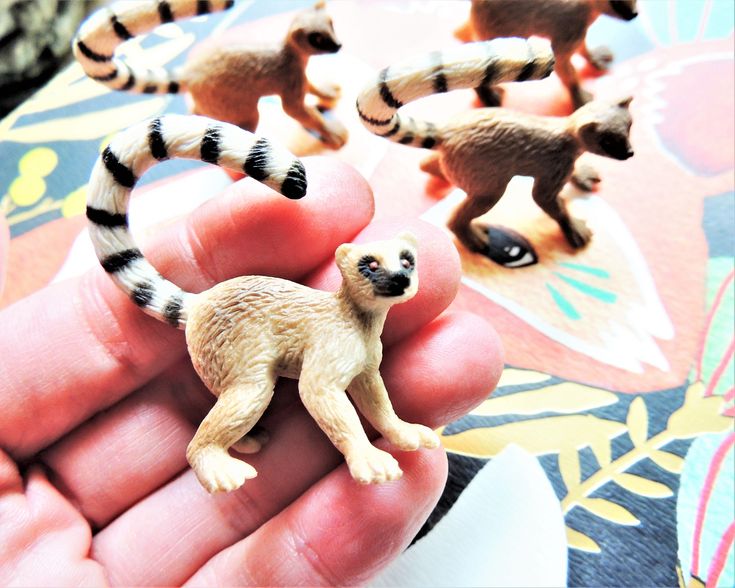
Coati, otter, ring-tailed lemur, brush tailed possum: Nayab. I am pretty sure that the hippo was made by Nayab too; wombat: Yowie, goldfish and dog: no name, rabbit: Schleich (2005)
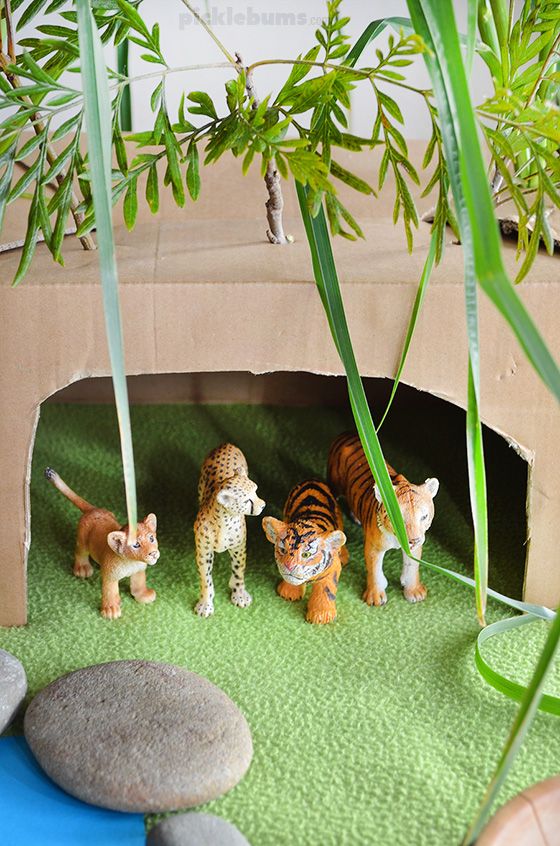
The tiger family : Schleich (2007), the lioness and lion cub: CollectA (2010), and the polar bears: Schleich (2011)
ANIMALS AND THEIR YOUNG MATCHING ACTIVITY
This is a wonderful activity that supports the development of a child's visual analysis and synthesis skills (crucial for early literacy and numeracy skills).
It is very simple to set up, you just need animal babies and their parents (or one of them), and ask your child to match the animal to their young.
LEARNING OPPOSITES
Animal figures can make learning the opposites effortless. You can start off by explaining the size difference (big vs small) or the weight difference (light vs heavy) of some of the figures, and help your child to sort them into groups. Sorting is a beginning math skill, so thanks to this activity your toddler will not only learn the opposites but also start applying logical thinking into everyday life.
the boar: E.L.C; piglet: AAA, the tiny pig: Britais; lobster, ant: no name, small octopus was added to an activity book 'Animal Adventures: Ocean Play Kit' by Silver Dolphin Books; black sheep: AAA, snake, rat and bat: no name; scorpion, goldfish, octopus: no name;
COLOUR SORTING
This simple activity supports the development of sorting skill as well as colour knowledge. To set it up, I used a few pieces of colour paper that I laid out on a table (if you have paper plates or bowls in many colours they will be perfect too), and animals on a small tray.
Your child can sort only animals, or you can toss in some more objects if you wish.
INTERMEDIATE ACTIVITIES:
Giraffe: Schleich (1998), zebra: Schleich (2008)
MATCHING ANIMALS TO THEIR SKIN COVERS
Your child can practise the visual discrimination through matching the animal skin covers to animal figurines. You can print the close-ups of skin covers off of the internet. I made mine using the A4 Animal Print Card that I randomly found in Wilko. It used to be my son's favourite activity when he was 1.5-2 years old.
Dog: no name, the house and peg doll made by me;
INCORPORATE THEM INTO IMAGINARY PLAY
Animal figurines are perfect for incorporating to block play (even Lego Duplo), loose parts play or doll houses. And here- the sky is the limit. If your child doesn't initiate the play, you can prep an invitation consisting of some blocks, loose parts, animal figurines or scarves that you already have at home. They will immediately start creating a small world with the items you provided, and you will be blown away by their imagination.
Ostrich, rooster, goose, duck: AAA; eagle, macaw, falcon, puffin: Schleich, kiwi: SSS Stewarts
SORTING ACTIVITY
This activity is great because it literally grows with your child. The older and more advanced your baby is, the more play possibilities will appear. There are many different ways of sorting animals, for example- animals with tusks vs animals without tusks. Mammals vs reptiles, animals with wings vs animals without wings.
You can introduce sorting very early, even when your child only knows 2-3 animals. And then ask him to sort cats with cats, sheep with sheep and dogs with dogs etc. Once he gets the idea, he will ask for more activities like this, which would be an awesome opportunity for him to learn more animal names and their body parts.
ANIMAL RESCUE
Animal rescue is a fun activity that helps to develop fine motor skills and critical thinking. You can prepare many different variations of it (like sticking animals to a flat surface with washi tape, putting several elastic bands on the figurines etc.), I, however, decided to thread some jute twine through the holes of the clothespins basket, and I asked my son to rescue the little animal figurines using tongs.
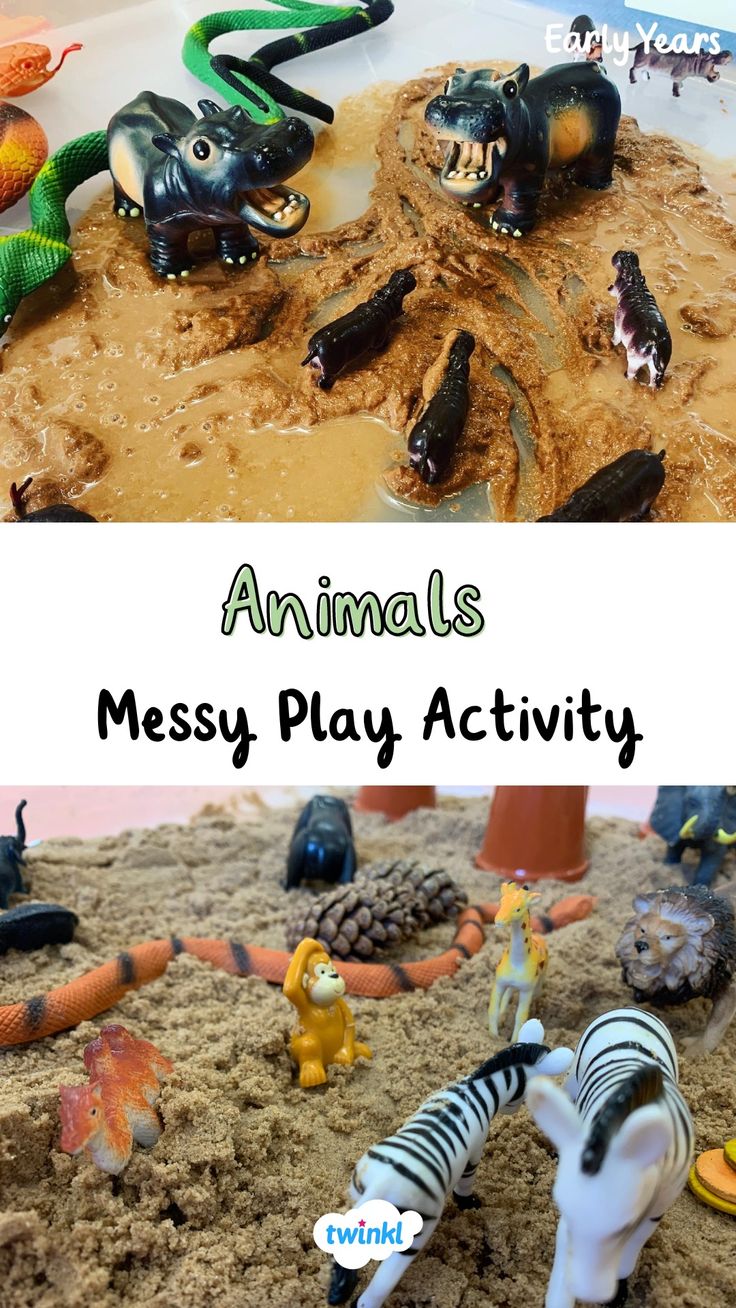
Sea horse, guitar fish, hedgehog, eagle, falcon, snowy owl, chipmunk: Schleich; sheep: AAA; octopus, clown fish were added to an activity book 'Animal Adventures: Ocean Play Kit' by Silver Dolphin Books; koala: K&M, green chromis: Learning Resources
SORTING- LAND, AIR, WATER
This simple activity will help your child to understand that some animals live mainly in the air, water or land.
You can set it up in many different ways. You can have photos of an ocean, land and sky and ask your child to sort the animals into three groups. The other, and fun alternative, is displaying three jars: one 'empty' (containing the air), one with water, and one with sand/ soil and grass. If your child can read, you can just write the words 'land', 'air' and 'water' on small pieces of papers, and ask your child to sort the animals accordingly.
ANIMAL BODY PARTS
This is a fantastic way to expand your child's vocabulary. Choose an animal that your child loves the most, and gradually name his body parts. You can start off by introducing the most distinctive ones, like tusks and trunk for an elephant, a beak and wings for an eagle. You will realize how quickly your child will spot that some animals have the same body parts.
Horse (2002), rabbit (2010), moose (2016): Schleich; rat: no name
WHAT FOOD DO ANIMALS EAT
I usually teach my son about animal food preferences in three ways:
- we read about them together,
- he chooses an animal and asks me what does he eat, and I go through all of the food items that animal eats,
-or I do it the way shown on the photo- I place a certain food item and animals on a tray together, and then we discuss it.
Next time I would prepare a larger amount of animals, and ask him to choose and place on a tray only the animals that eat that specific food.
1st rabbit: AAA, 2nd: no name, 3rd: Schleich (2010), 4th: Schleich: (2005)
COUNTING AND SORTING ACTIVITIES
Kids are usually beyond excited when they start to understand the concept of counting. My son usually counts all of the animals he plays with, or sorts them into groups and then counts them. Having beautifully crafted items will encourage kids to do simple math activities.
VET PRETEND PLAY
Kian has always been a fan of pretend play, and doctor pretend play is just what he loves the most. Sometimes his doctor kit becomes a vet kit, and he checks on the animals.
The play is crucial for children, and it is a fantastic opportunity for us, parents, to pass on them the value of caring for others, including animals, through play.
Sea horse (2013), red deer (2013), Texas longhorn bull (2012): Schleich; kiwi bird: SSS Stewarts, tarantula (2009): CollectA; stork: no name, but I am pretty sure it is a copy of Schleich
A SIMPLE MEMORY GAME
I remember playing this memory game in kindergarten. It is very easy to set up, yet so effective. All you need to do is to choose a few animal figurines (you can, of course, add some other items), put them on a tray or a table and let your child explore them. Give him 1-2 minutes for exploration, then ask him to close his eyes (or turn around), meanwhile, you remove one of the figurines, and hide it under a scarf/ a bowl/ under the table. Your child needs to guess which one is gone. Have fun!
1st rabbit: AAA; 1st horse (2015): Schleich; 2nd rabbit (2010): Schleich; 2nd horse (2002): Schleich; 3rd rabbit: no name; adult horse in a bowl: E.L.C ; baby horse in a bowl: no name; rabbit in a bowl (2005): Schleich
FINISH THE PATTERN
Understanding patterns is an important skill for mathematical operations, logic and critical thinking.
Your patterns can be as simple, or as difficult as you want. If you don't have many animal figurines for the activity, toss in some random items you find at home. Teaspoons, building blocks, clothespins. Anything! I went for the rabbit/horse pattern, but it could be as well spoon/animal/spoon/animal one.
ADVANCED ACTIVITIES:
Sea horse (2013) and kangaroo (2008): Schleich; koala: Science & Nature; wombat: Yowie; dolphin: no name; kiwi: SSS Stewarts; clown fish was added to an activity book 'Animal Adventures: Ocean Play Kit' by Silver Dolphin Books;
HABITAT STUDY
I have to admit that this is an activity I learned so much from! The set up is so simple- put animals on a tray and help your child to place them on a map of a particular continent. We usually use the maps included in Usborne Children's Picture Atlas, because they are kid-friendly, but you can use any map you want.
I classified this activity as an advanced one, but my son has been enjoying matching animals to the map since he was 18 months old. You can try it with your toddler, but if he doesn't understand it right away- don't worry, the continent study is not a skill that toddlers need to master. But it is certainly a fun activity for kids 🙂
Praying mantis (2009), musk ox (20018): CollectA; mandrills (2013), moose (2016), wooly mammoth (2002): Schleich
SHADOW TRACING ACTIVITY
This can be an outdoor, or indoor activity, and it is the easiest one to set up. All you need is a little bit of sunshine (luxury goods, I know), a figurine, a piece of paper and a pen/pencil/crayon/colouring pen/ or a marker.
Panda (2011), asian elephant (2015), tiger (2007), gorilla female and baby (2011): Schleich
LEARN ABOUT ENDANGERED AND VULNERABLE SPECIES AND HOW TO HELP THEM
Humanity has wiped out a ridiculous amount of animals in recent years. Thankfully, we are now all trying to stop that madness, and make more mindful lifestyle choices. We also need to nurture children's in-born innocence and love for nature, and we can do so by explaining the need to care for the planet and animals. I usually choose a few figurines and explain to my son what risk are particular animals facing (like plastic in the oceans, arctic ice melting faster than it freezes in winter). I have not I introduced him to some issues yet, like hunting, ivory trade or dogfighting, because he is simply too small.
And important thing- how can we help the animals? We all can make a difference by not picking up foods containing the palm oil, wasting less plastic, water and energy. I recently found a fantastic book in our local library -'How to Help a Hedgehog and Protect a Polar Bear' by Jess French. It is a kid-friendly book which talks about simple ways to protect animals in different habitats, from the hedgehog or a bee in our garden to those living far away from us.
Red deer: Schleich (2013)
FIGURINES BECOME MODELS FOR DRAWING
No matter if your child wants to draw, paint or sculpt, the beautifully made and detailed animal figurines can become fantastic 'models' for him. It is not only a fun activity but also a way to relax, communicate emotions and feelings, practice fine motor skills and boost creativity.
Schleich African elephant (2011) and Schleich male Asian elephant (2015). My son's favourite figurines :)
OBSERVE AND LEARN THE DIFFERENCES WITHIN THE VARIOUS TYPES/BREEDS OF SPECIES
From the size of ears and tusks for elephants to various, and possibly countless, differences between the breeds of dogs- there is so much that your child can learn. Animal figurines can be a massive help here, because they are detailed, and they allow your child to study their bodies without the need of having his hand eaten by a shark, or having to swim in the Arctic ocean in search of narwhals. But if they inspire your child to become a zoologist-awesome!
Zebra foal, elephant calf: AAA; zebra (2008), African elephant (2011), chimpanzee female and baby (2012): Schleich
MAKING DIORAMAS
Making dioramas is one of the most creative activities including animal figures. It is very educational, as you not only introduce your child to continent study, sorting animals by habitats, teach them about different trees, plants and flowers, but it also is a fantastic art activity.
The diorama that I have made was also a zero cost project, using 'rubbish' and some materials I found at home. You can find step-by-step instructions here.
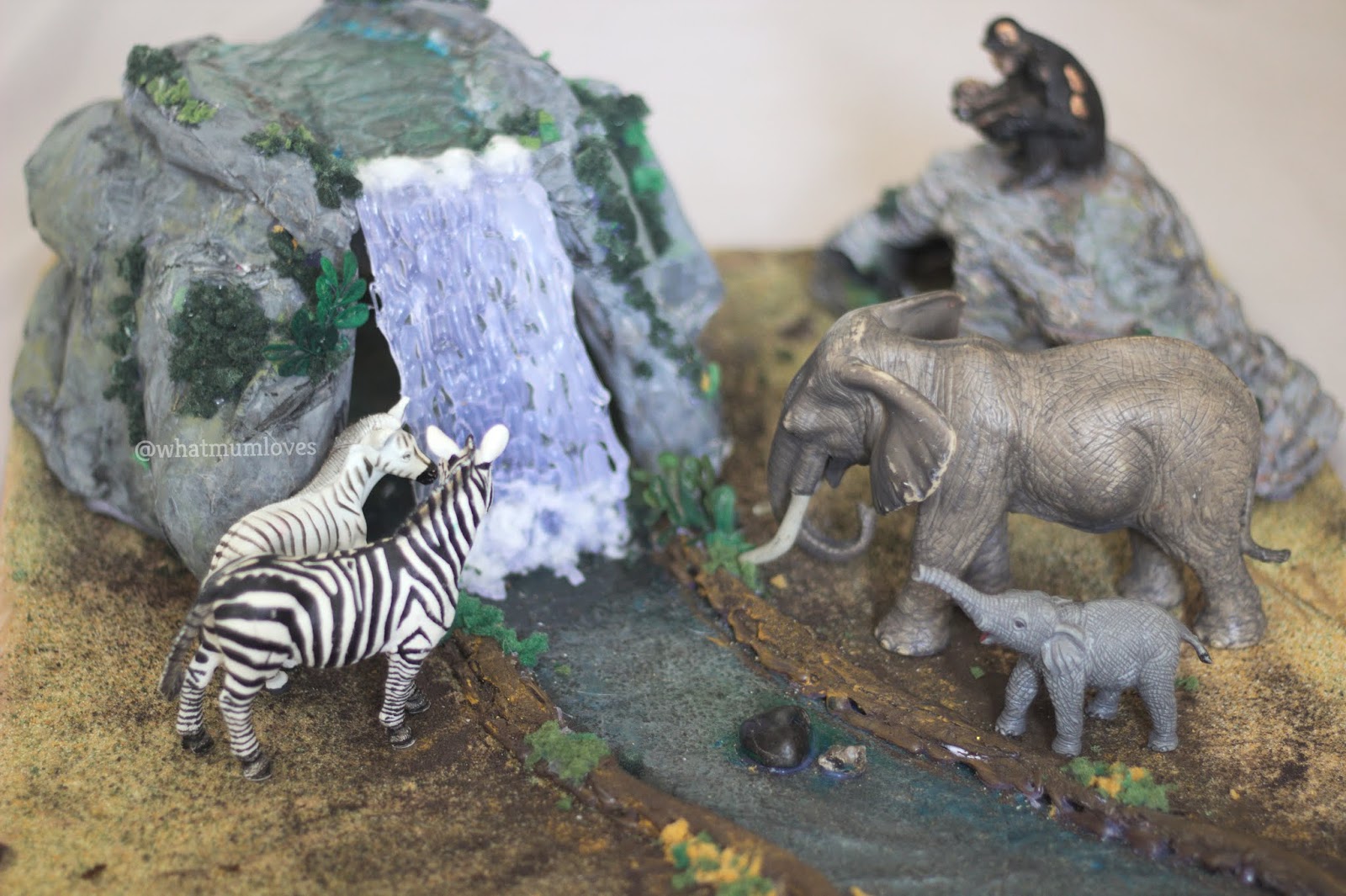
Falcon, snowy owl, macaw, budgerigar, puffin, eagle: Schleich; kiwi: SSS Stewarts; stork, owl: no name; rooster, goose, duck, hen, ostrich: AAA
FLYING AND FLIGHTLESS BIRDS
Discovering which birds are flightless will be very interesting for your child. After you explain the concept of flying/ being flightless, you can encourage your child to start sorting the birds based on it. The more advanced is your child, the more information about the birds you can expose him to, starting with the name, the continent they live in, the food they eat, and- what is important- why they do/do not fly.
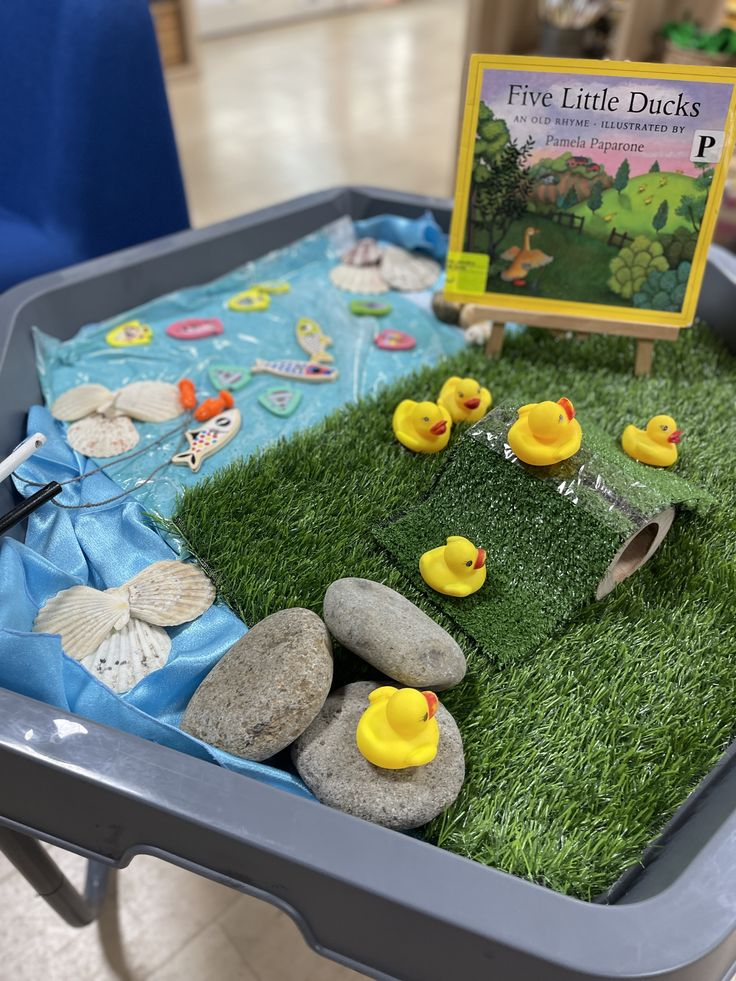
NOCTURNAL/ DIURNAL ANIMALS SORTING ACTIVITY
My son loves to observe the fox that lives around our house form the balcony. He understood that the fox comes out of his den in the bushes in the evenings, which was a fantastic opportunity for me to explain to him that some animals are mostly diurnal, and some mostly nocturnal (this is how far I explained it to a 2-2.5 years old child, later I will certainly introduce more details). Then we started sorting them into groups, and I have to say that learning about animal activity times was fascinating for my son.
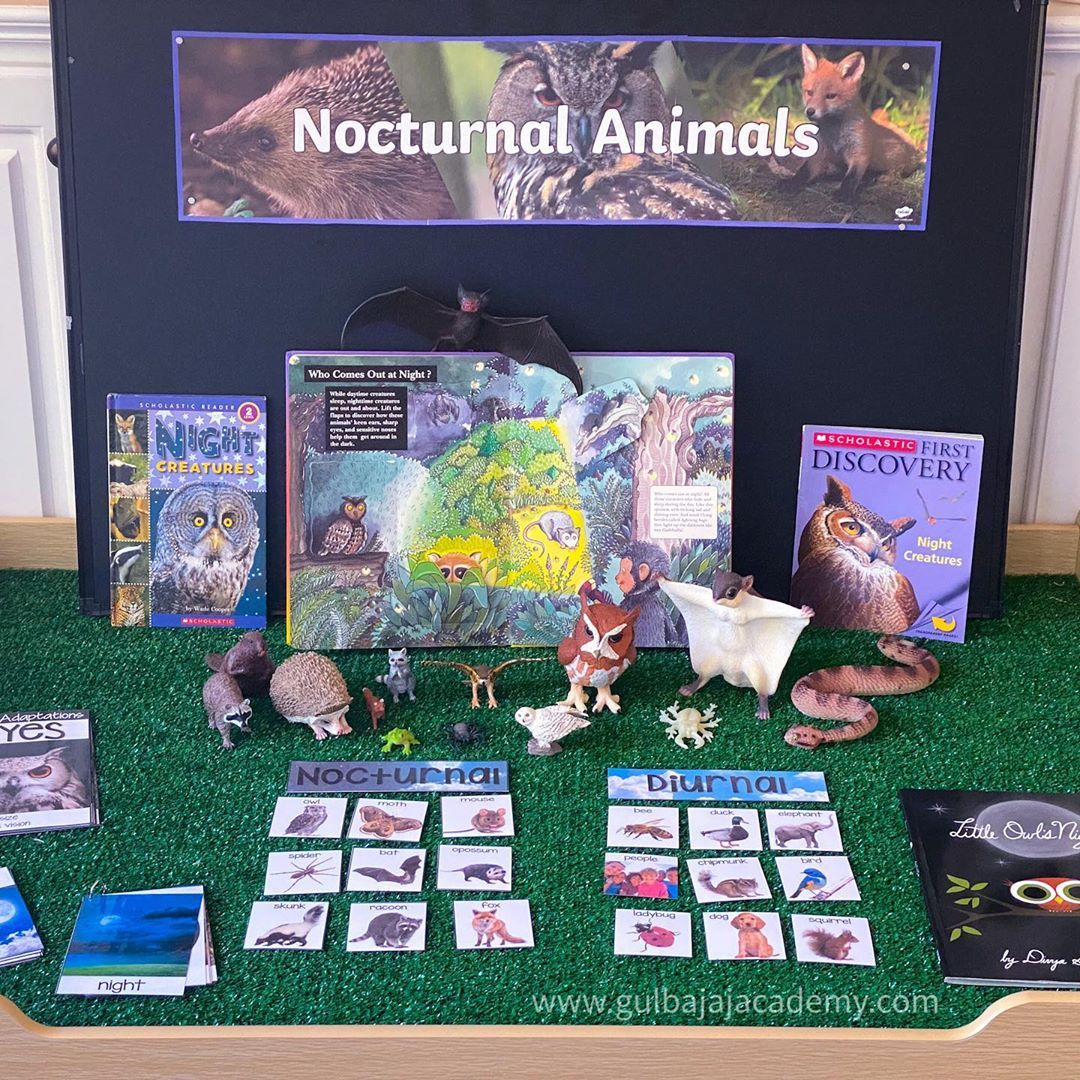
Centipede, frog: no name; grass hopper (2009): CollectA; bear (2003) Schleich; the food chain cards are from 'Into the Forest, Nature's Food Chain Game' by Ampersand Press), the pieces of human skeleton model: 'The Amazing Human Body' Gold Stars (book with activities and models)
FOOD CHAIN ACTIVITY
Learning about animal food chain is the only one out of all of the activities presented today that my son has not tried yet. I simply struggle to tell him that some animals kill other animals for food. But if your child knows this already (or if you aren't a chicken like me), it is a perfect time to teach him about the food chain.
You can set this activity up in many ways, here I just used a few animal figurines, some parts of the human skeleton model to represent the 'death and decay', and some cards from a food chain game that we have at home ('Into the Forest, Nature's Food Chain Game' by Ampersand Press), but you can just print and laminate (or not) the cards with animal photos on them. You can always support yourself with books about the food chain because this is a topic that kids will ask thousands of questions on.
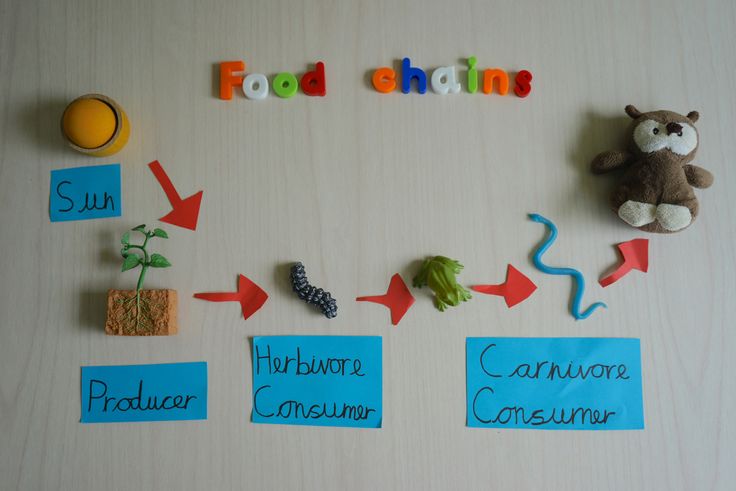
These are all of the activities I prepared for you for today. Remember that kids are born with a natural desire to learn and grow, our job as parents or guardians is not to kill it in them, so keep the activities fun, don't pressure your kids, and enjoy watching how they develop new skills, learn new words and have fun playing.
Seasonal Play Worlds
Winter Wonderland
Embrace the magic of a Winter Wonderland, where snowy landscapes, ice castles, and winter fun abound. This seasonal world is perfect for kids who love the charm and excitement of winter activities.
Description:
Snowy landscapes, ice castles, and winter fun
Snow-covered trees, sparkling ice sculptures, and cozy winter cabins
Suggested Activities:
Building Snow Castles: Use snow or white sheets to create snow castles. Kids can decorate their castles with glitter and pretend to be royalty in their icy domain.
Winter Sports: Set up winter sports activities like a mini ice skating rink (using a smooth surface), snowball fights (with soft balls), and sledding (using flat surfaces or cardboard).
Summer Paradise
Step into a Summer Paradise, filled with beaches, tropical islands, and sunny adventures. This world is ideal for kids who enjoy the warmth and fun of summer play.
Description:
Beaches, tropical islands, and sunny adventures
Sandy shores, palm trees, and sparkling blue waters
Suggested Activities:
Beach Games: Set up beach-themed games like sandcastle building, beach volleyball (with a soft ball and net), and seashell scavenger hunts.
Treasure Hunts in the Sand: Bury small treasures in a sandbox or designated area. Kids can dig for hidden treasures and imagine they are on a tropical island adventure.
Autumn Harvest
Celebrate the beauty of autumn with an Autumn Harvest world, featuring pumpkin patches, hayrides, and harvest festivals. This setting is perfect for kids who love the colors and festivities of fall.
Description:
Pumpkin patches, hayrides, and harvest festivals
Colorful leaves, scarecrows, and bountiful harvests
Suggested Activities:
Harvest Games: Organize harvest-themed games like apple bobbing, pumpkin bowling (using small pumpkins and pins), and sack races.
Building Scarecrows: Provide materials like old clothes, hay, and sticks for kids to build their own scarecrows. They can decorate them and set them up in the yard.
Seasonal worlds offer a dynamic and ever-changing backdrop for imaginative play. By exploring these settings, kids can enjoy the unique activities and charms of each season, fostering a deeper appreciation for the natural world. Encourage them to embrace the magic of winter, the warmth of summer, and the bounty of autumn as they create unforgettable seasonal adventures.
Sci-Fi Worlds
Futuristic City
Step into a high-tech world with a Futuristic City, where advanced gadgets, flying cars, and robots fill the landscape. This setting ignites kids’ imaginations about what the future might hold and encourages innovative thinking.
Description:
High-tech gadgets, flying cars, and robots
Skyscrapers, holograms, and advanced transportation systems
Suggested Activities:
Robot Building: Provide materials like cardboard boxes, aluminum foil, and craft supplies to build robots. Kids can design their robots with unique features and create stories about their robotic friends.
Futuristic Scavenger Hunts: Create a scavenger hunt with futuristic-themed items hidden around the yard. Kids can search for items like “holographic” stickers, “energy” crystals (colored stones), and “cyber” gadgets (toy parts).
Alien Planet
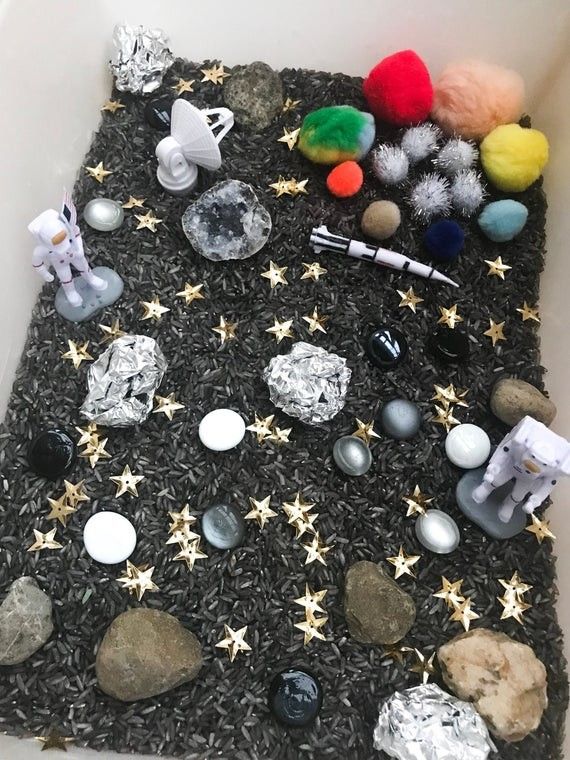
Venture into the unknown with an Alien Planet, where strange landscapes and alien creatures await discovery. This world is perfect for kids fascinated by the idea of life beyond Earth.
Description:
Strange landscapes, alien creatures, and unknown flora
Unique terrain features like glowing rocks, bizarre plants, and alien habitats
Suggested Activities:
Alien Life Discovery: Set up a mini alien planet in the yard with colorful plants (made from pool noodles or paper flowers) and strange creatures (stuffed animals or homemade aliens). Kids can explore the planet, looking for signs of alien life and collecting “samples” (small objects).
Intergalactic Missions: Create a mission where kids must gather “resources” (colored balls or objects) from the alien planet while avoiding obstacles. They can work together to complete their mission and return to their spaceship.
Time Travel Adventures
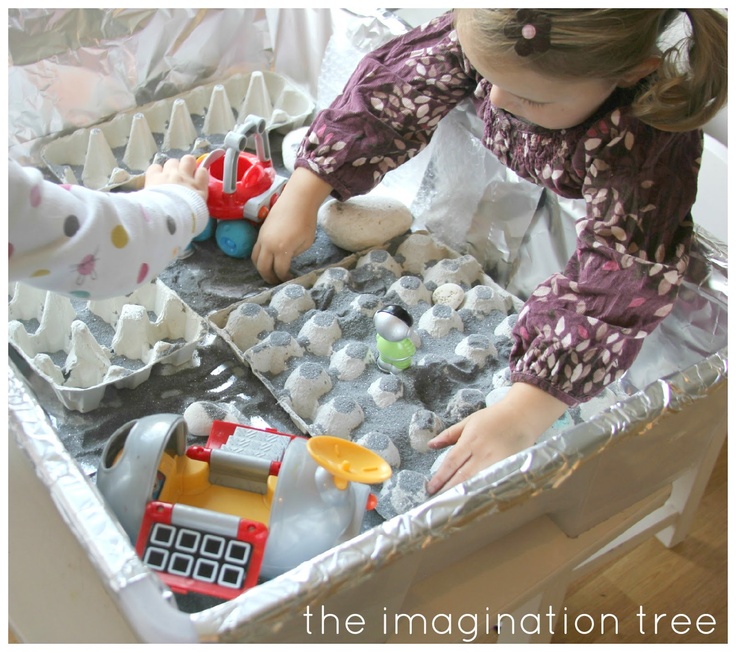
Travel through different eras with Time Travel Adventures, where kids can visit various points in history or the future. This world encourages learning about different time periods and the concept of time travel.
Description:
Traveling through different eras, from the past to the future
Time machines, historical landmarks, and futuristic settings
Suggested Activities:
Building Time Machines: Use cardboard boxes, old electronics, and craft supplies to build time machines. Kids can decorate their time machines with dials, buttons, and “time travel” elements.
Time-Travel Missions: Design missions where kids must travel to different time periods to complete tasks. They can gather historical artifacts, solve ancient mysteries, or bring back futuristic technology.
Sci-fi worlds offer endless possibilities for imaginative play, allowing kids to explore the realms of the future, alien life, and time travel.
By immersing themselves in these settings, children can stretch their creativity, problem-solving skills, and curiosity about the unknown. Encourage them to dream big and explore the infinite possibilities of sci-fi adventures.
Haunted House
Dare to enter the Haunted House, filled with ghosts, haunted mansions, and spine-tingling mysteries. This spooky world is perfect for kids who enjoy a good scare and love solving mysteries.
Description:
Ghosts, haunted mansions, and eerie atmospheres
Creaky floors, hidden passageways, and spooky sounds
Suggested Activities:
Ghost Hunting: Hide paper ghosts or ghost toys around the yard. Kids can use “ghost detectors” (flashlights or toy gadgets) to find and capture the ghosts.
Mystery Solving: Create a mystery for the kids to solve, such as finding a hidden treasure or uncovering the secret of a haunted room. Provide clues and puzzles for them to work through.
Superhero City
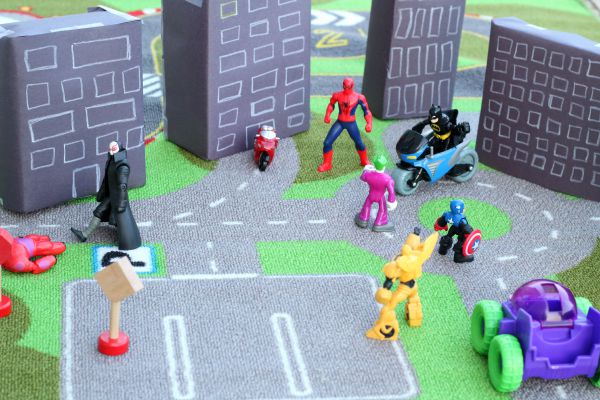
Fly into action in Superhero City, where heroes, villains, and superpowers create an exciting and dynamic world. This realm encourages kids to embrace their inner superheroes and save the day.
Description:
Heroes, villains, and superpowers
Skyscrapers, secret lairs, and bustling cityscapes
Suggested Activities:
Superhero Training: Set up an obstacle course with challenges like climbing, jumping, and crawling. Kids can train to improve their superhero skills and earn “superhero badges” for completing the course.
Rescue Missions: Design scenarios where kids must use their superpowers to rescue a stuffed animal or save a part of the yard from an “evil villain.” They can work together to overcome obstacles and complete their mission.
Magical realms offer an enchanting escape into worlds filled with wonder, mystery, and excitement. By stepping into these realms, kids can unleash their creativity, develop problem-solving skills, and enjoy the thrill of magical adventures. Encourage them to cast spells, solve mysteries, and save the day as they explore these captivating settings.
Underwater Worlds
Mermaid Lagoon
Dive into the enchanting world of Mermaid Lagoon, where mermaids, underwater castles, and sea creatures create a magical underwater adventure. This world is perfect for kids who love the ocean and mythical sea beings.
Description:
Mermaids, underwater castles, and sea creatures
Coral reefs, sparkling lagoons, and hidden underwater treasures
Suggested Activities:
Underwater Treasure Hunts: Hide small treasures like shells, plastic jewels, and coins in the yard. Kids can pretend to swim through the lagoon and search for the hidden treasures.
Mermaid Role-Play: Create mermaid tails from fabric or use blankets. Kids can pretend to be mermaids, swimming gracefully and exploring the underwater world.
Sunken Treasure
Explore the mysterious Sunken Treasure world, filled with shipwrecks, treasure chests, and underwater caves. This setting is ideal for adventurous kids who love the thrill of discovering hidden riches.
Description:
Shipwrecks, treasure chests, and underwater caves
Sunken ships, coral-covered chests, and secret underwater passages
Suggested Activities:
Treasure Dives: Set up a treasure hunt where kids dive (pretend to swim) to find hidden treasure chests. Fill the chests with small toys, coins, or treats.
Underwater Exploration: Create an obstacle course that simulates underwater exploration. Kids can navigate through hoops (coral tunnels) and crawl under sheets (cave passages) to find treasures.
Atlantis
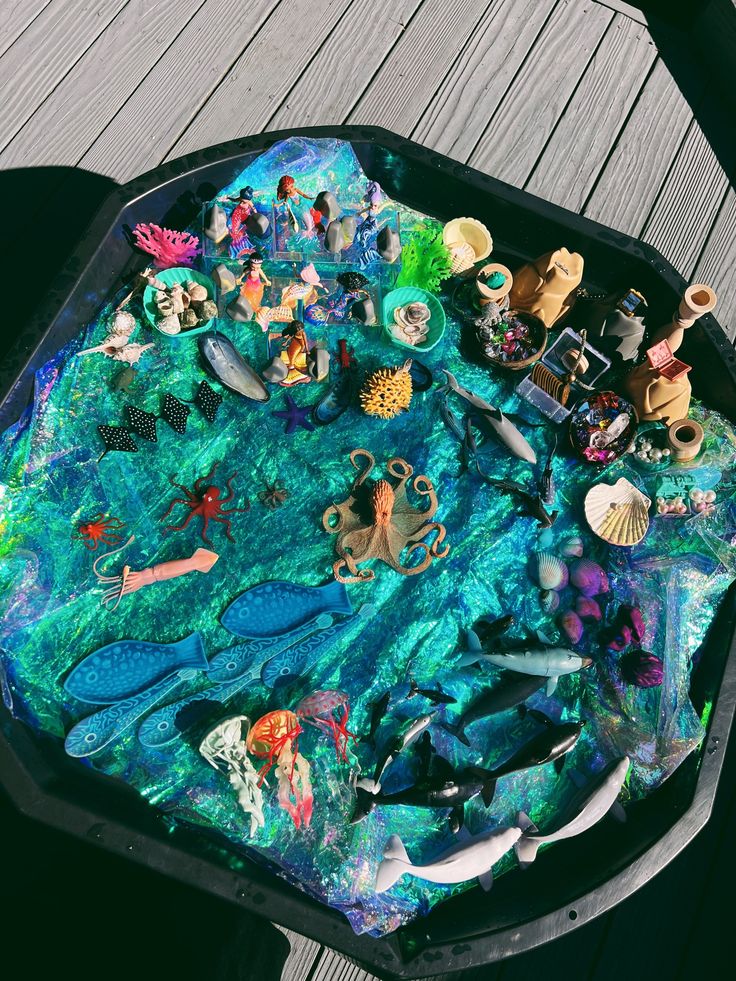
Journey to the mythical city of Atlantis, an advanced underwater civilization filled with wonders and mysteries. This world sparks curiosity about ancient legends and futuristic technology.
Description:
Mythical underwater city, advanced technology
Glowing buildings, advanced machinery, and mysterious artifacts
Suggested Activities:
Atlantis City Building: Use blocks, cardboard, and other materials to build a model of the city of Atlantis. Kids can design and decorate their own version of this legendary place.
Exploration Missions: Design missions where kids must find and retrieve ancient artifacts from the city of Atlantis. They can solve puzzles and overcome challenges to complete their missions.
Underwater worlds offer a captivating escape into the depths of the ocean, where kids can let their imaginations swim free.
By exploring these magical and mysterious settings, children can engage in creative play, develop problem-solving skills, and enjoy the wonders of the underwater realm. Encourage them to dive deep and discover the secrets of these enchanting underwater worlds.
A Lost and Forgotten Jungle
The Lost Jungle is a wild and mysterious place, filled with exotic animals, hidden temples, and brave explorers. This world encourages kids to embrace their inner adventurer and discover the secrets of the jungle.
Description:
Wild animals, hidden temples, and intrepid explorers
Dense foliage, ancient ruins, and jungle trails
Suggested Activities:
Jungle Safari: Set up a jungle trail in the yard with stuffed animals and clues about different jungle creatures. Kids can go on a safari, spotting animals and learning fun facts about them.
Treasure Hunts: Create a map leading to a hidden jungle temple. Along the way, kids can face challenges like crossing “rivers” (blue tarps) and climbing “mountains” (small hills or piles of cushions).
Space Odyssey
Blast off into the final frontier with Space Odyssey! In this imaginary world, kids become astronauts exploring alien planets and distant galaxies. This setting is perfect for sparking interest in science and space.
Description:
Outer space, astronauts, and alien planets
Spacecraft, distant stars, and extraterrestrial landscapes
Suggested Activities:
Space Mission Games: Set up a space station in the yard with cardboard boxes and tin foil. Kids can pretend to be astronauts on a mission, conducting experiments and fixing their spaceship.
Alien Planet Exploration: Create an alien planet with colorful plants (use pool noodles or paper flowers) and strange creatures (stuffed animals or homemade aliens). Kids can explore the planet, looking for signs of alien life and collecting “samples” (small objects).
